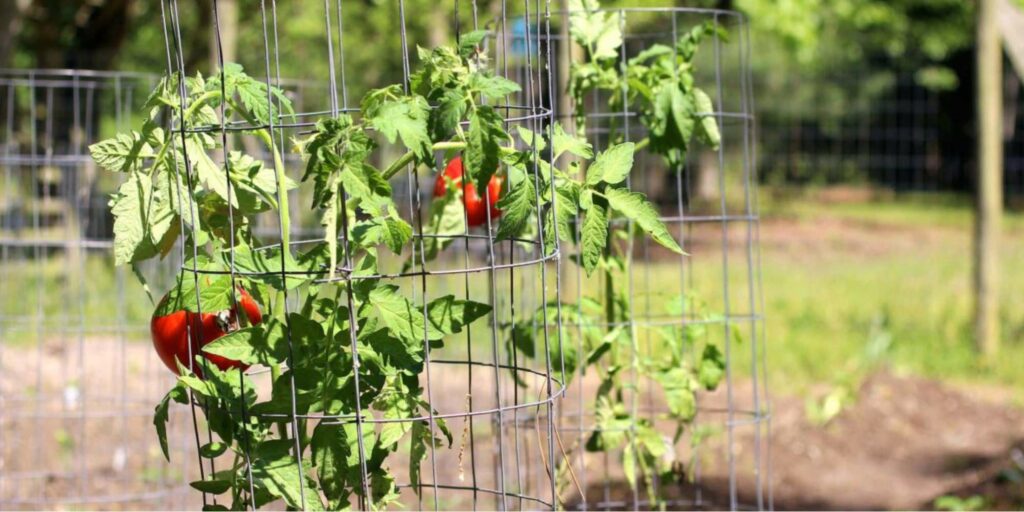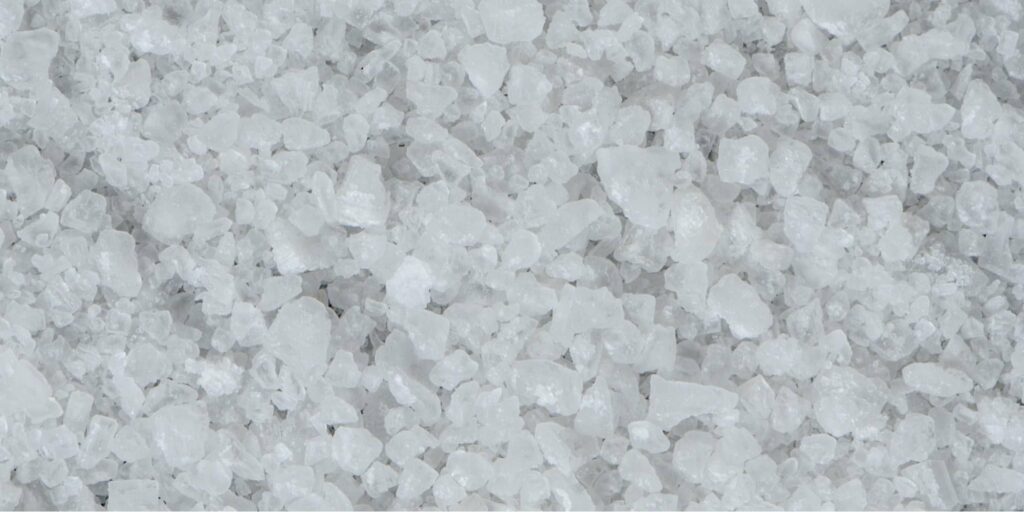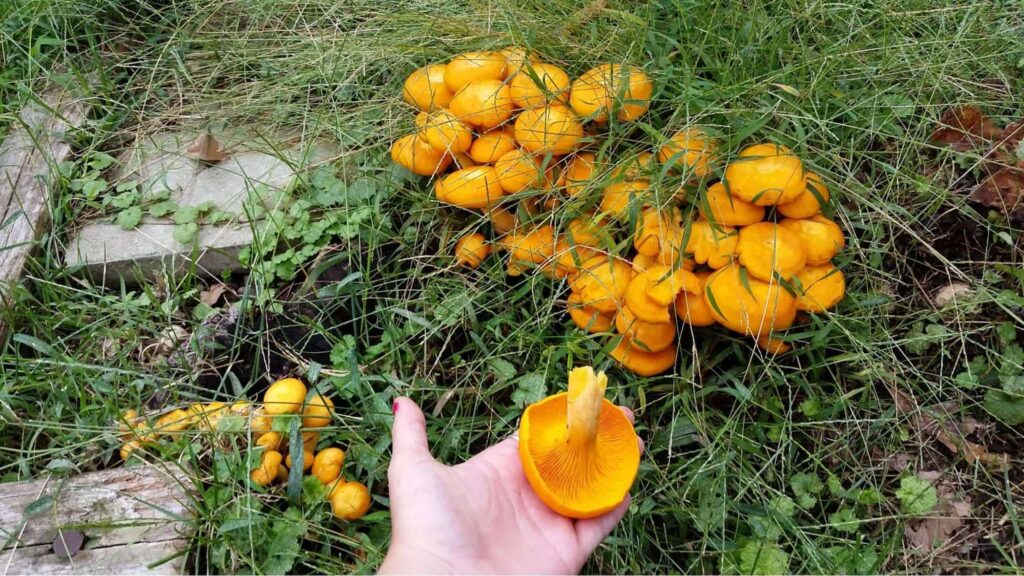
It’s crazy to think that there are over 10,000 known species of mushrooms. There are a ton that come in wildly bright colors, add a sweet or savory taste to dishes, and even a couple that are poisonous.
Knowing which mushroom species are growing in your backyard is essential to determine whether they’re safe to have around, especially in the midst of children and pets.
Luckily, we’ve broken down all of the things you should know about those orange mushrooms growing in your backyard.
What Are The Orange Mushrooms In the Yard?
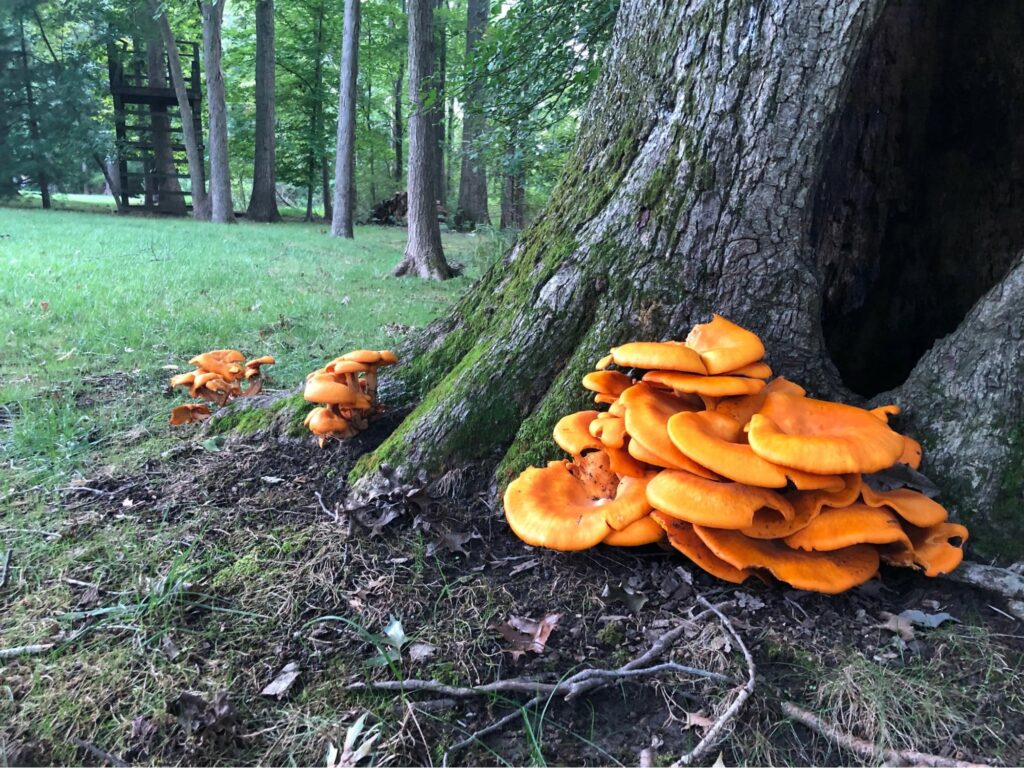
There are many species of orange mushrooms found all over the planet. The most common are:
- Jack O’Lantern
- Orange Mycena
- Orange Peel Fungus
- Chicken of the Woods
Orange mushrooms are primarily found on logs, barks, shrubs, and decaying organic matter.
Some species are poisonous to humans and animals.
Why Do I Have Orange Mushrooms in the Yard?
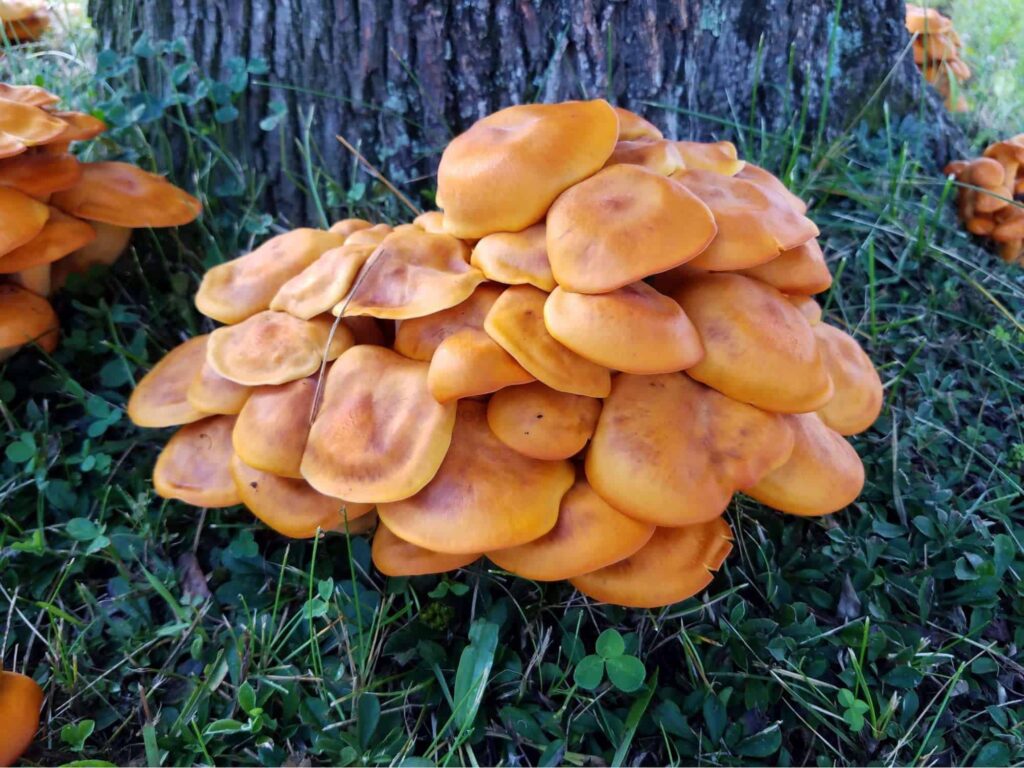
If you’ve been noticing orange mushrooms sprouting out of nowhere, this may mean that your backyard has environmental conditions that are conducive for orange mushroom growth.
These include:
- High humidity levels
- Constant wet conditions
- An abundance of organic matter
- Temperatures ranging from 55°F to 60°F
Mushroom spores can travel with the wind or water, which means they can be hiding in plain sight just waiting for the right conditions to germinate.
1. High Humidity
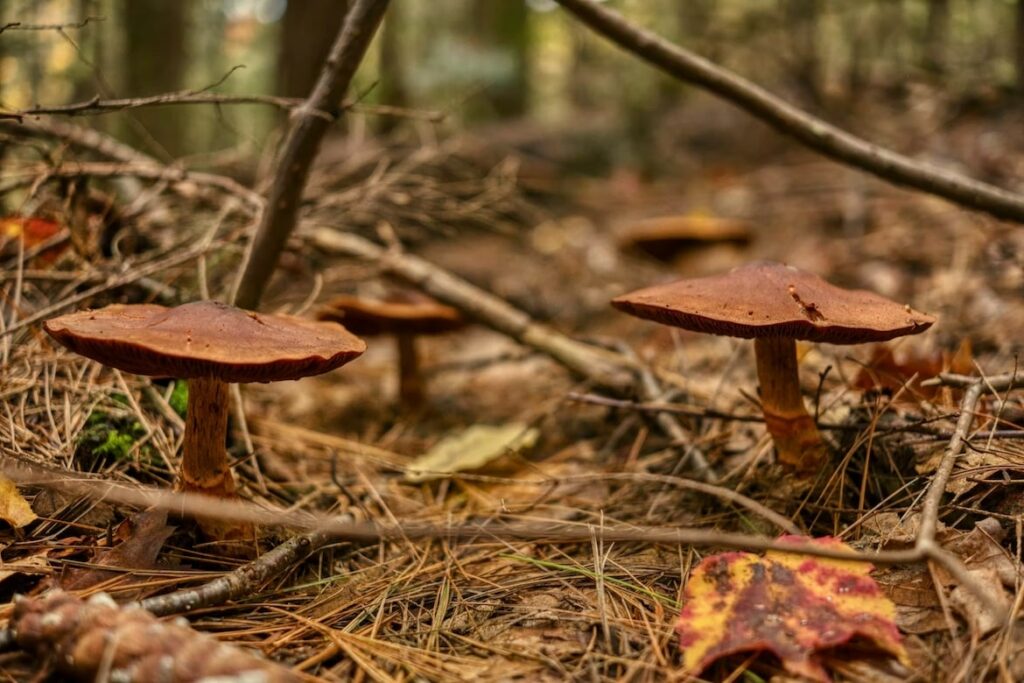
Did you know that mushrooms are made up of nearly 90% water? Hence, they’ll need consistently high levels of humidity – at least 80% – to thrive.
Inadequate levels of humidity will hinder orange mushrooms from properly developing. As a result, they could have stunted growth, cracks, and discoloration, among other deformities.
This is why most orange mushroom growers have a humidifier to help them control and maintain optimum humidity levels. The ideal Relative Humidity (RH) should be anywhere between 80% to 90%.
2. Wet Conditions
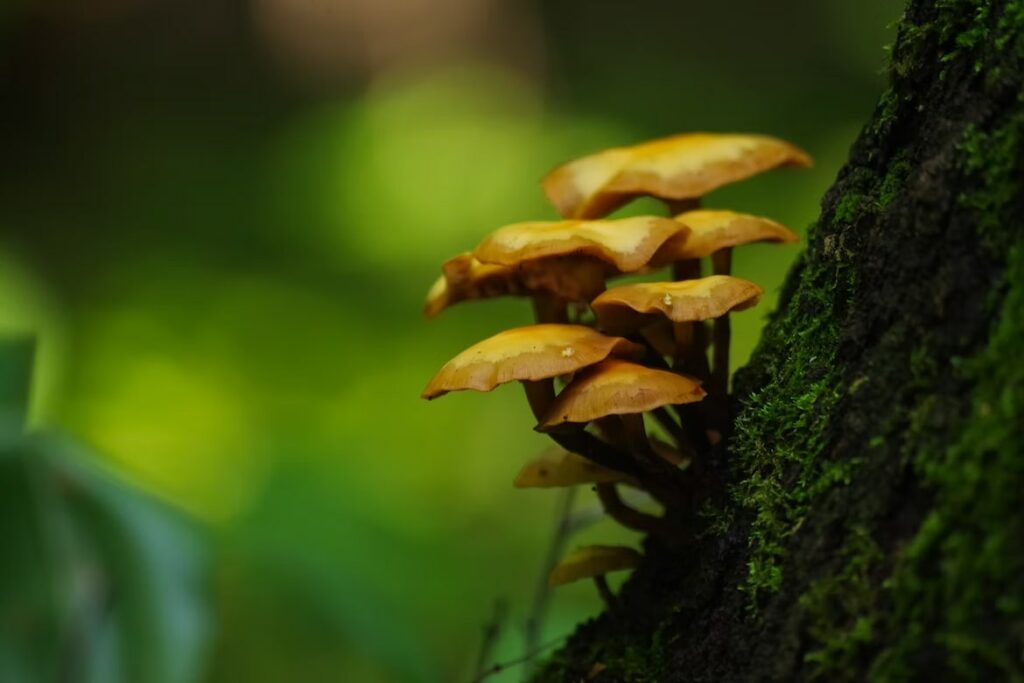
Since orange mushrooms are a type of fungi, they grow best in moist environments. Wet environments help orange mushrooms grow bigger and increase their reproduction rates.
Whether it be brought by rain or constant watering, damp conditions encourage orange mushroom growth.
Though, many notice orange mushrooms popping up right after it rains. This is most likely because the droplets of rainwater cause the orange mushrooms to release spores into the air.
As a result, you’ll often find dense clusters in a single spot. Otherwise, the spores stay within the air until the next rainfall.
3. Abundance of Organic Matter
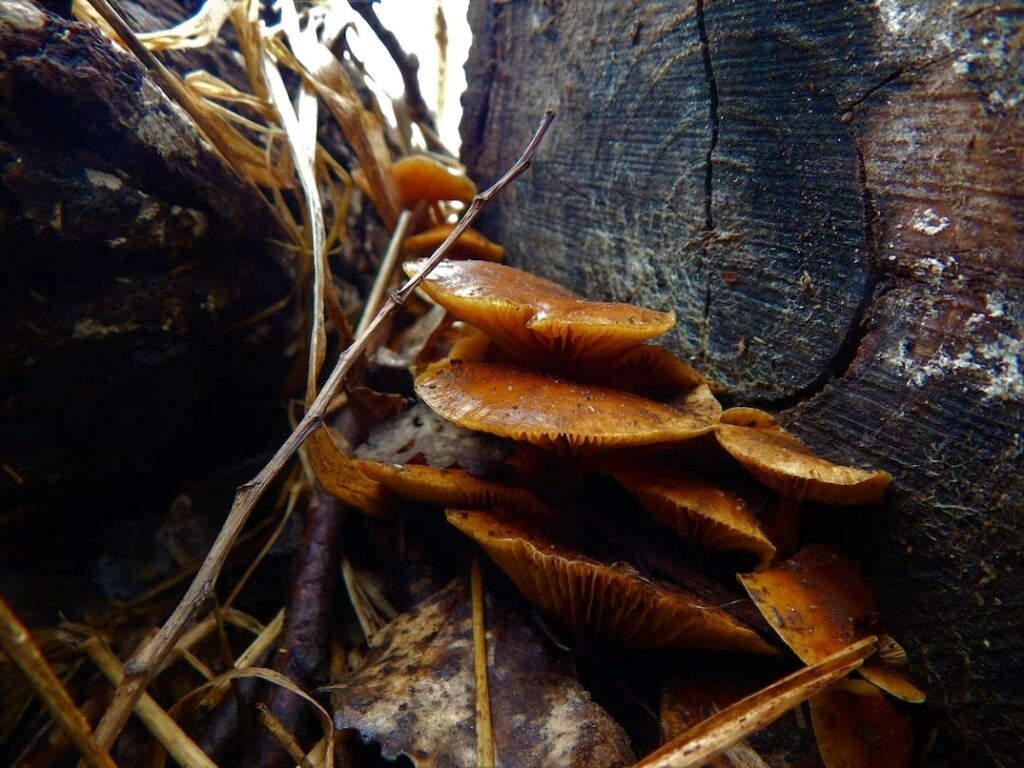
Mushrooms play an enormous role in our ecosystem as natural decomposers. They grow and feed on decaying organic matter such as tree barks, logs, branches, and even animal tissue, among others.
They help break down dead plants and animals by releasing enzymes that help them absorb the nutrients from the decomposing organisms.
What’s cooler is that they can also feed on nasty contaminants within the soil.
Hence, you’ll often be able to spot them growing on tree barks, decaying logs, and fertile soil.
Despite all of these pluses, it’s not a wise idea to grow orange mushrooms alongside your other plants as they depend on feeding on organic material for survival.
They’ll also take all of the nutrients in the soil faster than your plant can, which can inhibit proper growth and development.
4. Ideal temperatures
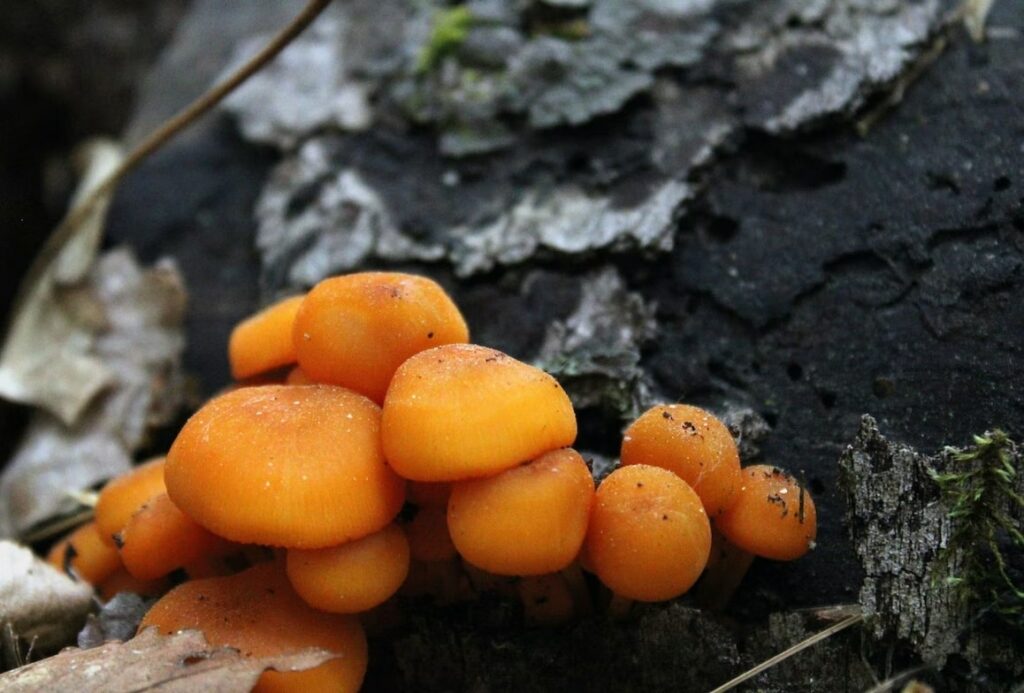
Just like any other plant, ideal temperatures help stimulate a quicker growth rate. For mushrooms, they grow well in environments with temperatures ranging from 55°F to 60°F.
Keep in mind that temperature tolerance will vary on the type of orange mushroom. Some varieties can withstand temperatures reaching 70°F.
Identifying Orange Mushrooms in the Yard/Lawn:
There are several species of orange mushrooms that can be found anywhere, even in your very own backyard.
Despite their innocent-looking appearance, there are several kinds of orange mushrooms that are actually toxic.
In fact, there are around 80 that are fatal when eaten while others have harmful consequences when touched.
Having said that, it’s important to know what kind of orange mushroom you’re dealing with to avoid unwanted harm.
1. Jack O’Lantern Mushroom
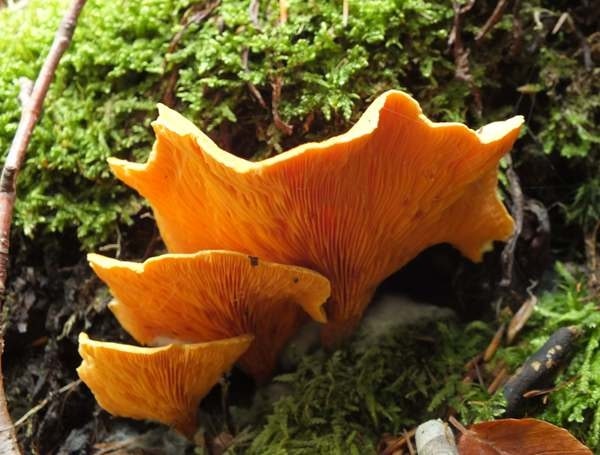
| Scientific Name | Omphalotus olearius |
| Common Name | Jack O’Lantern Mushroom |
| Family | Marasmiaceae |
| Toxicity (Touch) | No |
| Toxicity (Ingestion) | Yes |
| Unique Characteristics | Non-forking gills underneath the capGlow a faint neon-green color in the dark |
While seemingly fairytale-esque, you’ll need to be wary of the Omphalotus olearius, especially since they’re regularly seen in backyards.
They have non-forking gills underneath and are commonly found growing on dead wood in large, dense clusters.
In particular, they tend to grow on wood varieties such as:
- Chestnut
- Beech
- Oak
- Olive
- Oleaster
You’ll begin to find them sprouting in the late summer through fall on stumps or buried wood. Funnily, the latter gives the illusion that they’re growing from the soil.
They were given the nickname “Jack O’Lantern Mushroom” because their yellowish orange color resembles decorative pumpkins used during Halloween.
They even have bioluminescent properties, which gives them the ability to glow in the dark. It’s pretty interesting to see that their gills glow a faint blue-green color at night.
Hence, we can definitely understand the temptation to pick one up to examine it closer. Thankfully, they aren’t toxic when touched, but we still wouldn’t recommend it.
The Jack O’Lantern Mushroom contains illudin, a toxin that can cause severe diarrhea, abdominal cramps, and vomiting once ingested. A couple of patients also reported feeling dizzy, weak, and had difficulties breathing.
Because of this, it’s best to keep your distance as touching the orange mushroom could accidentally put you at risk.
2. Orange Mycena or Lea’s Mycena
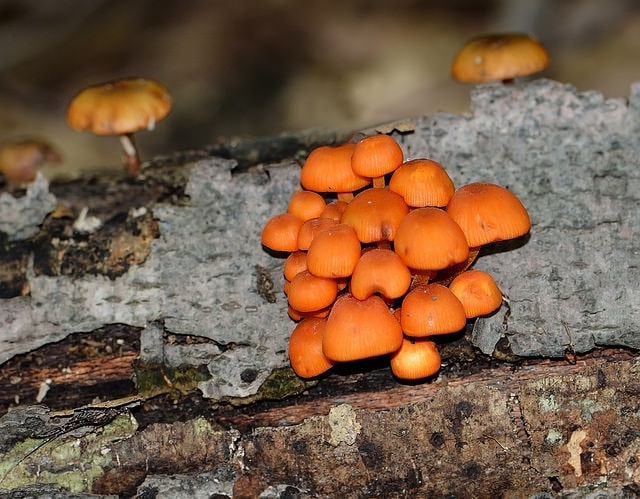
| Scientific Name | Mycena leaiana |
| Common Name | Orange Mycena or Lea’s mycena |
| Family | Mycenaceae |
| Toxicity (Touch) | No |
| Toxicity (Ingestion) | Unknown |
| Unique Characteristics | Only grow to about 1.5 inches or 4 centimeters in diameterHas a smooth yet sticky bell-shaped capHas reddish orange gills |
Orange mycena or scientifically known as Mycena leaiana, are small mushrooms that only grow to about 1.5 inches or 4 centimeters in diameter.
It has a bell-shaped cap that’s smooth and a tad sticky. Its underside has reddish orange gills that are pretty crowded and aren’t entirely attached to their thin stem.
As the orange mushrooms mature, they begin to lose their bright orange hue for a more dull shade. Aside from that, their cap also begins to convex, forming a tiny cavity at the center.
Despite originating in North America, different varieties of the Orange mycena can also be found in parts of New Zealand and Australia.
You’ll typically spot them in woodland areas, growing in clusters, and feeding on dead organic matter. They’re known to easily break down tougher wood varieties.
While it isn’t known to be poisonous, it isn’t recommended to ingest the Orange mycena either. Touching them is also known to leave stains on the skin.
3. Orange Peel Fungus
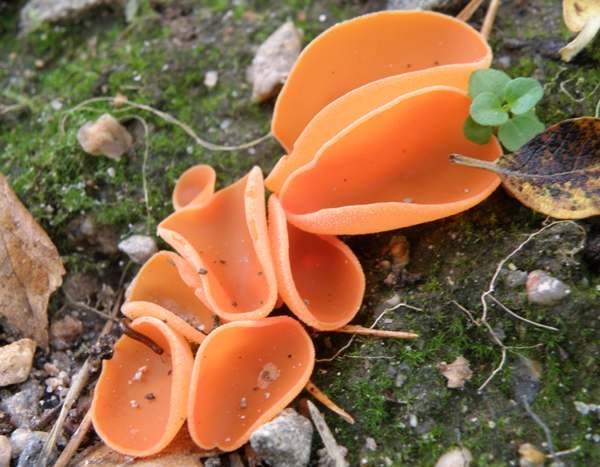
| Scientific Name | Aleuria aurantia |
| Common Name | Orange Peel Fungus |
| Family | Pyronemataceae |
| Toxicity (Touch) | No |
| Toxicity (Ingestion) | No |
| Unique Characteristics | Shaped like a contorted bowlDon’t have stems |
The Orange Peel Fungus looks identical to, well, an orange peel. From their color to their shape, the contorted bowl-shaped orange mushroom actually looks like a peel that was thrown on the ground.
This is especially so since they’re only around 4 inches or 10 centimeters tall, don’t have stems, and are often found on the ground.
You can find them primarily across North American and Europe, particularly in woodland areas, growing in clusters.
Since they’re tertiary decomposers, they have to wait for organisms at the bottom of the food chain to break down dead matter.
Luckily, the Orange Peel Fungus isn’t toxic as it isn’t known to secrete any poisonous substances. Nevertheless, it’s rarely ever included as an ingredient when cooking because it barely has any taste.
Having said that, they’re usually left alone as they closely resemble the Hare’s Ear fungus (Otidea fungi), which is toxic. Hence, it’s best to leave them alone to do their job at enriching the soil.
4. Caesar’s Mushroom
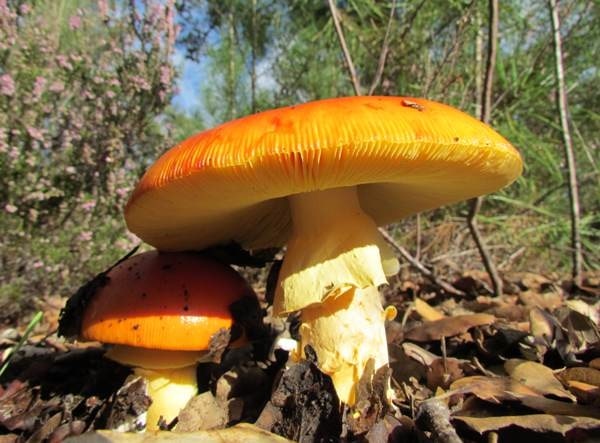
| Scientific Name | Amanita caesarea |
| Common Name | Caesar’s Mushroom |
| Family | Amanitaceae |
| Toxicity (Touch) | No |
| Toxicity (Ingestion) | No |
| Unique Characteristics | Can grow to about 18 centimeters acrossHas marginal slits on the capsThe cap has several irregular vein-like fragments |
Caesar’s Mushroom is a delicacy for many, usually harvested at its best stage when it most closely resembles an egg.
If not harvested then, the cap will continue to fully expand to around 6 to 18 centimeters across along with several irregular vein-like fragments.
In warmer climates, it’s typical to notice small marginal slits on the caps as a result of moisture loss.
Underneath the cap, they have pale yellow gills that are often compacted. Just below, they’ll have a ring around their rather thick, pale yellow stem.
Interestingly, Caesar’s Mushroom wasn’t actually called that when it was first discovered in 1772.
It was only when it became a highly regarded personal favorite of notable Roman Emperors, many of whom were named Caesar, that the mushroom’s common name was changed.
In fact, since Caesar’s Mushroom is native to southern Europe and North Africa, you’ll find many culturally significant recipes utilizing this ingredient going back more than 2,000 years.
Caesar’s Mushroom is a popular addition to many dishes because of its tenderness, fragrance, and mild flavor with notable hints of hazelnuts and chestnuts.
5. Goblet Waxcap or Chanterelle Waxy Cap
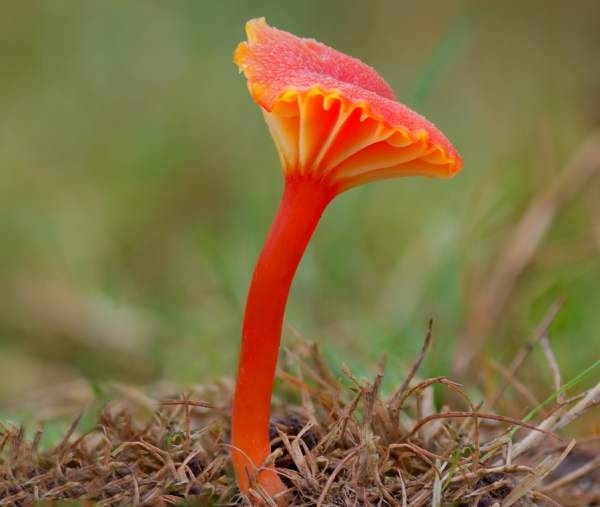
| Scientific Name | Hygrocybe cantharellus |
| Common Name | Goblet Waxcap or Chanterelle Waxy Cap |
| Family | Hygrophoraceae |
| Toxicity (Touch) | No |
| Toxicity (Ingestion) | No |
| Unique Characteristics | Convex-shaped caps with a slight dent in the centerEdges are lighter and twist inwards as they age |
Despite its small stature, the Goblet Waxcap or Chanterelle Waxy Cap is well-known for its bright light orange to reddish orange color that definitely stands out among the greenery.
A convex-shaped mushroom, they’re caps are typically dry and often have a slight dent in the center.
Unique about them is the edges of their caps lighten in color and begin to twist inwards as they age. Underneath, their gills are a pale yellow and often run downwards to the upper half of their slim stem.
They’re primarily found in the woodlands and grassy areas of eastern North America, Australia, and Europe. In particular, they absolutely thrive in mossy environments.
While they’re considered non-toxic, it’s believed that there’s insufficient data to completely support the notion that they can be ingested.
Even so, they’re rather bland and don’t have a distinctive smell, which doesn’t make them a popular choice to cook with in the first place.
6. Chicken of the Woods Mushroom or Sulfur Shelf
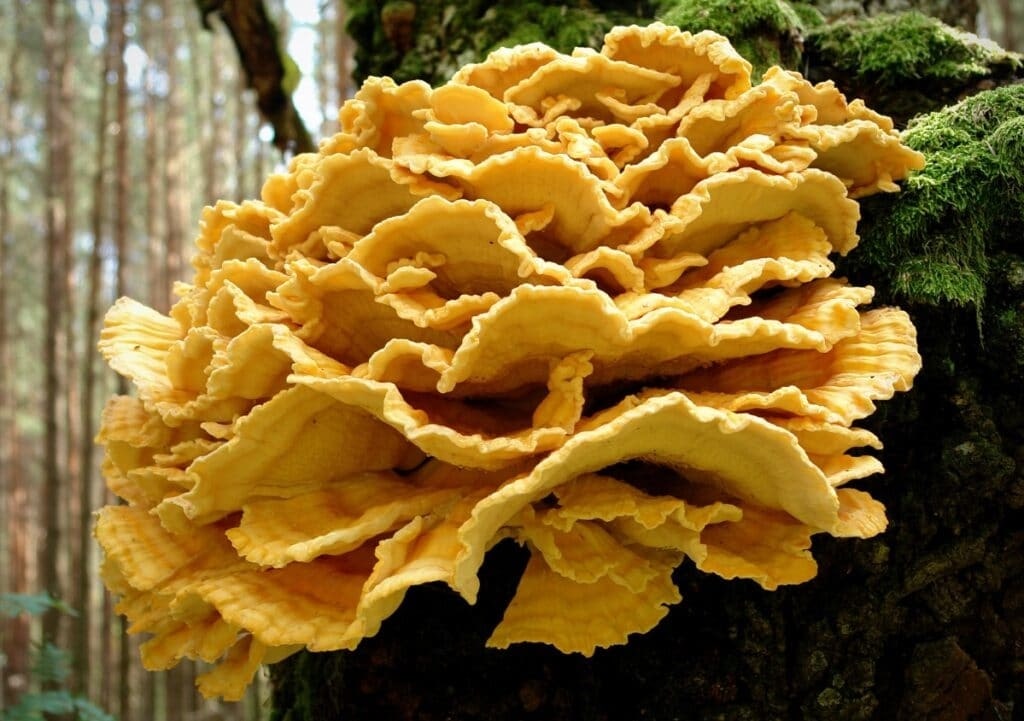
| Scientific Name | Laetiporus cincinnatus |
| Common Name | Chicken of the Woods Mushroom or Sulfur Shelf Mushroom |
| Family | Fomitopsidaceae |
| Toxicity (Touch) | No |
| Toxicity (Ingestion) | No |
| Unique Characteristics | Grow in shelf-like layersGrow to about 30 centimeters wide |
Chicken of the Woods Mushroom or Sulfur Shelf Mushroom is quite easy to recognize given their rather distinct shape.
They come in meaty layers that resemble shelfs, hence the name “Sulfur Shelf Mushroom”.
They’re also edible and have been known to taste like chicken when cooked, which is also why they’re referred to as the “Chicken of the Woods Mushroom”.
Given that they grow to as big as 30 centimeters wide and 20 centimeters tall, they make a hearty substitute to chicken meat for many dishes.
Though, they do have a rather tough consistency. On the bright side, their edges are known to be the tastiest part.
Having said that, it’s important to keep in mind that these mushrooms can only be safely consumed when cooked.
It’s not recommended to eat them raw as this could elicit allergic reactions in some people. Nevertheless, it’s best to try a small piece first to check how your body reacts.
As they mature, they lose their bright yellow-orange color and become white. They’re known to grow on hardwood trees like maple, cherry, and oak, among others.
However, it’s not advisable to ingest those that have grown on conifer, cedar, eucalyptus, and locust trees. These types of trees typically have toxic leaves, barks, and fruits, among others.
7. Lobster Mushroom
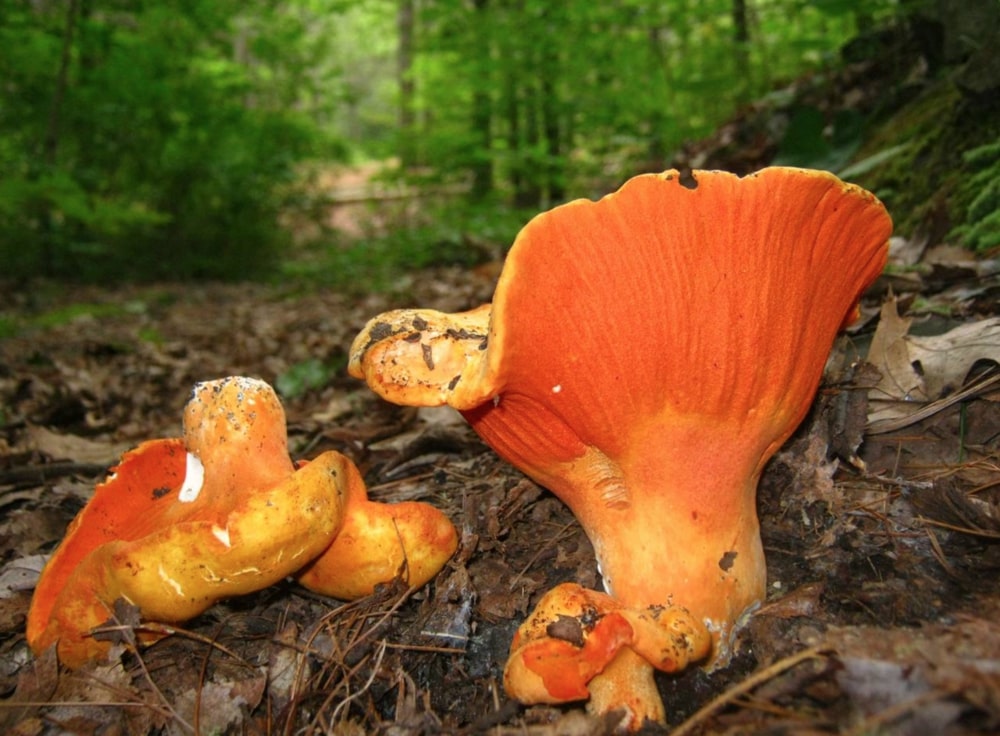
| Scientific Name | Hypomyces Lactifluorum |
| Common Name | Lobster Mushroom |
| Family | Hypocreaceae |
| Toxicity (Touch) | No |
| Toxicity (Ingestion) | No |
| Unique Characteristics | Resembles the tail of a cooked lobster |
The Lobster Mushroom was given its name because of how closely it resembles the tail of a cooked lobster with a bright reddish-orange color to match.
However, it’s actually a parasitic ascomycete fungus that infects its host mushroom, which are usually the Russula brevipes and Lactarius piperatus genera.
The parasitic fungi covers its host with a hard, dotted crust and contorts it. The fungus also alters the flavor and texture of its host by changing its chemical composition, making them taste better.
The Lobster Mushroom is actually edible and non-toxic. They have a mild shellfish/crustacean-like flavor that’s amplified once they’ve dried.
On top of that, they’re actually pretty big, too, which makes them rather filling. Many foragers collect Lobster Mushrooms to sell in local markets.
However, if they’ve turned a purplish color, smell rather fishy, and are lightweight, that means they’re too mature to be used for cooking.
While the lobster mushrooms can be eaten raw, it’s believed to taste better when cooked. Most recipes are rather simple, often only requiring pan-frying or sautéing.
Even so, there are some who’d argue that there are certain conditions that could cause the parasitic fungi to become inedible.
8. Red Pine Mushrooms or Saffron Milk Cap Mushroom
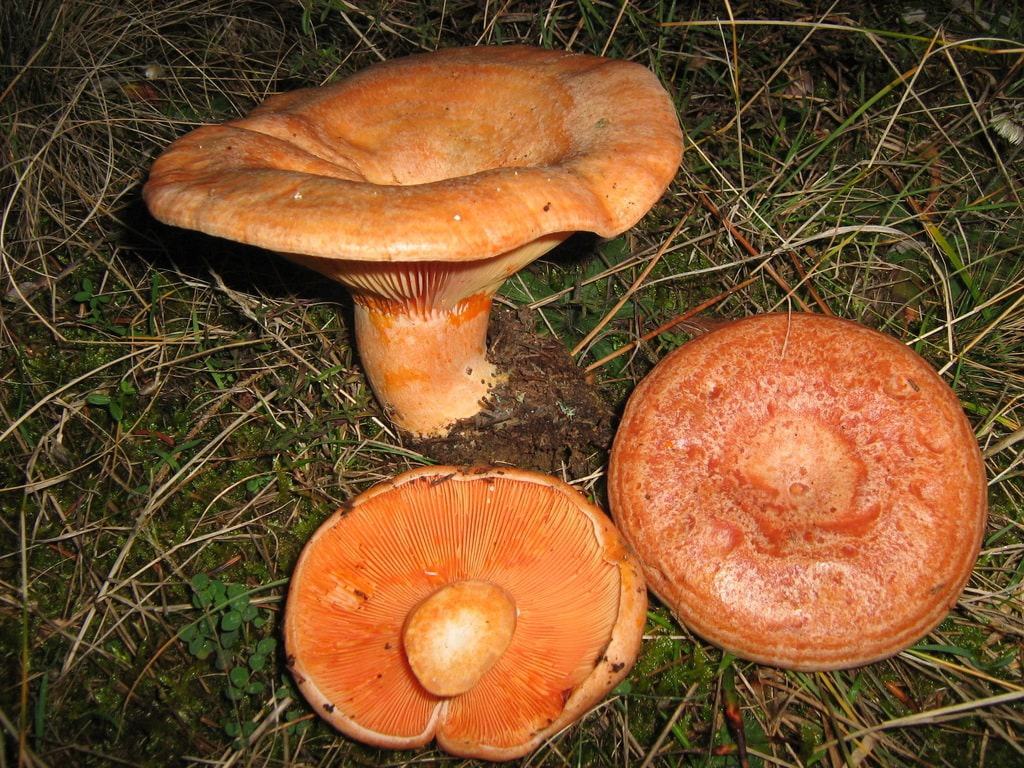
| Scientific Name | Lactarius deliciosus |
| Common Name | Red Pine Mushrooms or Saffron Milk Cap Mushroom |
| Family | Russulaceae |
| Toxicity (Touch) | No |
| Toxicity (Ingestion) | No |
| Unique Characteristics | Stains the skin dark green when handledReleases a milk-like substance when harvested or cut |
The Red Pine Mushrooms or Saffron Milk Cap Mushroom originated in Europe, most frequently found in recipes across Spain, Scotland, and Northern Britain.
It has since made its way around the world and onto the plates of many. They’re enjoyed for their firm yet crunchy texture along with their meaty and peppery flavor.
Having said that, they don’t really taste like what a traditional mushroom would. Hence, cooks love how versatile they can be depending on how they’re prepared.
We do have to warn you, though, that they tend to turn the entire dish orange.
However, they’re quite rare, which means that they have a rather hefty price tag attached to them.
While they’re still young, they’re usually a bright yellowish orange color with convex caps folding inwards along with tan colored spore prints. Their gills are a brighter orange shade and are usually compacted.
They’re typically found growing alongside coniferous trees. These include the likes of cedar, spruce, fir, and pine, most especially.
When handled, they could stain the skin dark green. Meanwhile, they release an orangey red milk-like substance when cut or harvested fresh.
9. Woolly Chanterelle
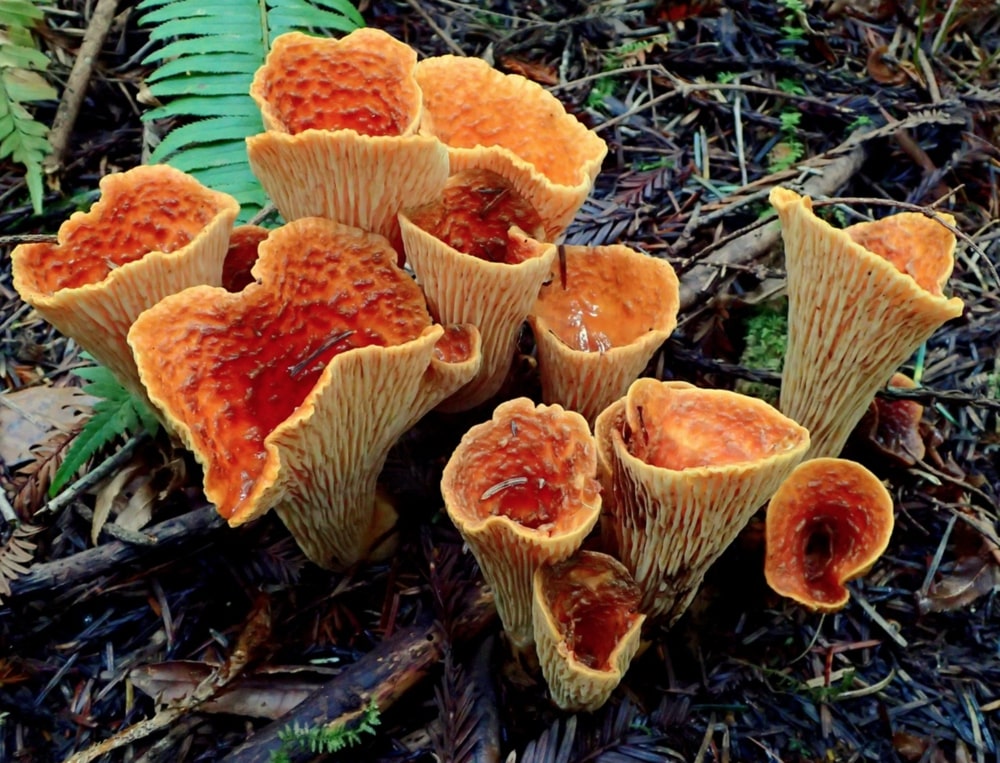
| Scientific Name | Turbinellus floccosus |
| Common Name | Woolly Chanterelle, Scaly Vase, Scaly Chanterelle, or Shaggy Chanterelle |
| Family | Gomphaceae |
| Toxicity (Touch) | Varies on region |
| Toxicity (Ingestion) | Varies on region |
| Unique Characteristics | Cylindrical Has pale yellow to cream colored gills on the outer region |
The Woolly Chanterelle goes by many names and is discernible by their cylindrical, vase-like shape.
As pictured above, they’re isn’t a distinct separation from the cap to the stem. They’re rather small at only 30 centimeters wide and across.
On the side are the gills which appear a wrinkled pale yellow to cream color that encompasses nearly the whole outer part.
They come in various shades, from reddish orange to yellowish orange depending on where they’re found.
Having mentioned that, they grow primarily in warm and humid environments with heavy rainfall. You’ll find them on the forest floor breaking down organic matter with ease.
As for their toxicity, this varies depending on where they’re grown. Varieties grown in the Pacific Northwest and British Columbia are considered toxic, while varieties grown in Mexico and India aren’t.
10. Orange Bonnet or Coral Spring Mycena
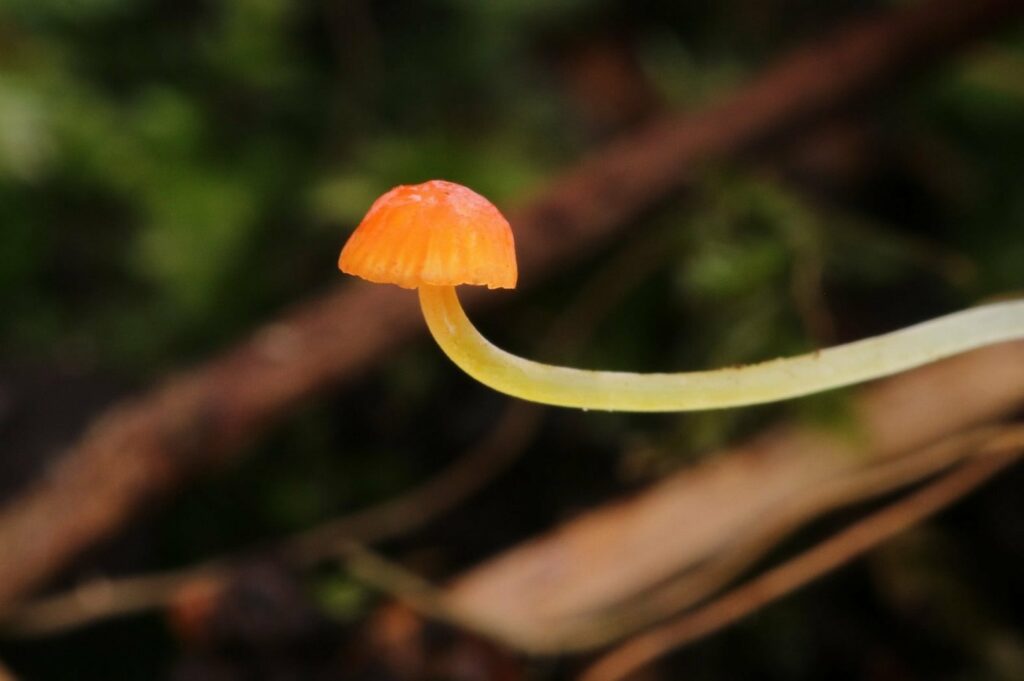
| Scientific Name | Mycena Acicula |
| Common Name | Orange Bonnetor Coral Spring Mycena |
| Family | Mycenaceae |
| Toxicity (Touch) | Unclear |
| Toxicity (Ingestion) | Unclear |
| Unique Characteristic | Slender stem that only grows about 6 centimeters longSmooth, hemispherical, red orangey cap that grows to about 1 centimeter in diameter |
The Orange Bonnet or Coral Spring Mycena is typically found in the Caribbean, Europe, North America, and Asia.
They look like any classic mushroom with a smooth, hemispherical, red orangey cap. As they age, streaks become more apparent, starting at the top to the edges.
Even at their most mature stage, they’re still quite small and only grow to about 1 centimeter in diameter.
They also have slender, cream or light yellow stems that only grow to about 6 centimeters long.
Underneath their caps, they have light yellow colored gills with adequate gaps and whitish yellow edges.
You can typically find Orange Bonnets growing in dense clusters in damp environments such alongside streams, forest floors, and wooden debris.
Unfortunately, it’s unclear whether they’re toxic. Nevertheless, it isn’t recommended to try to use them for cooking as there aren’t any recipes available that include them in their ingredients list anyway.
11. Eyelash Cup or Molly Eye-winker
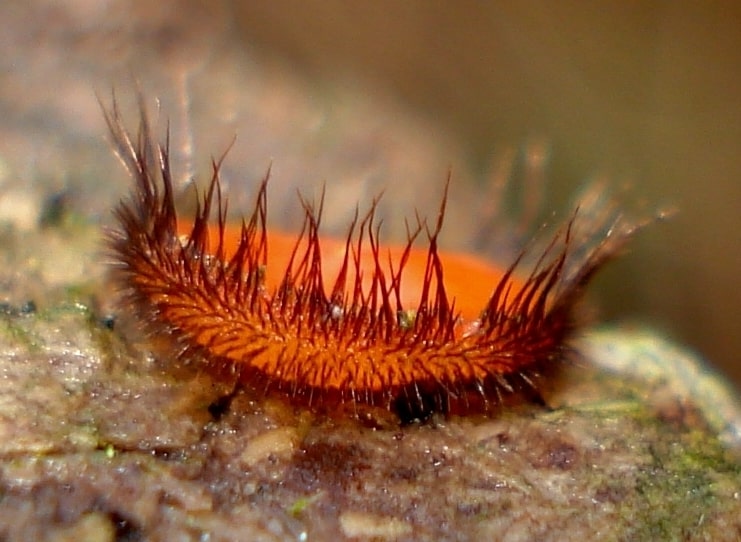
| Scientific Name | Scutellinia Scutellata |
| Common Name | Eyelash Cup or Molly Eye-winker |
| Family | Pyronemataceae |
| Toxicity (Touch) | Unclear |
| Toxicity (Ingestion) | Yes |
| Unique Characteristics | Bowl-shapedHas fine, black hairs along the edges |
Despite their abundance in many parts of the world, the Eyelash Cup or Molly Eye-winker often goes unnoticed due to the fact that they’re incredibly small.
As of date, the largest ‘cup’ grew to only 4mm across. Despite being bowl-shaped, eventually, their cup begins to flatten out with age.
It was given the name “Eyelash Cup” because of the fine, black hairs along the edges of its cap that resemble eyelashes. Without close inspection with a magnifying glass, you may completely miss them.
As mentioned earlier, Eyelash Cups can be found virtually anywhere in the world, from Europe all the way to Asia.
In particular, you’ll be able to spot them hanging out in swamp-like environments that are constantly humid and moist.
They primarily grow in clusters, but there are some that grow on their lonesome. They’re often seen on damp soil, decaying wood, and organic matter.
While they’re reported to not have a distinctive taste, it isn’t recommended to eat them.
12. Reishi Mushroom or Lingzhi
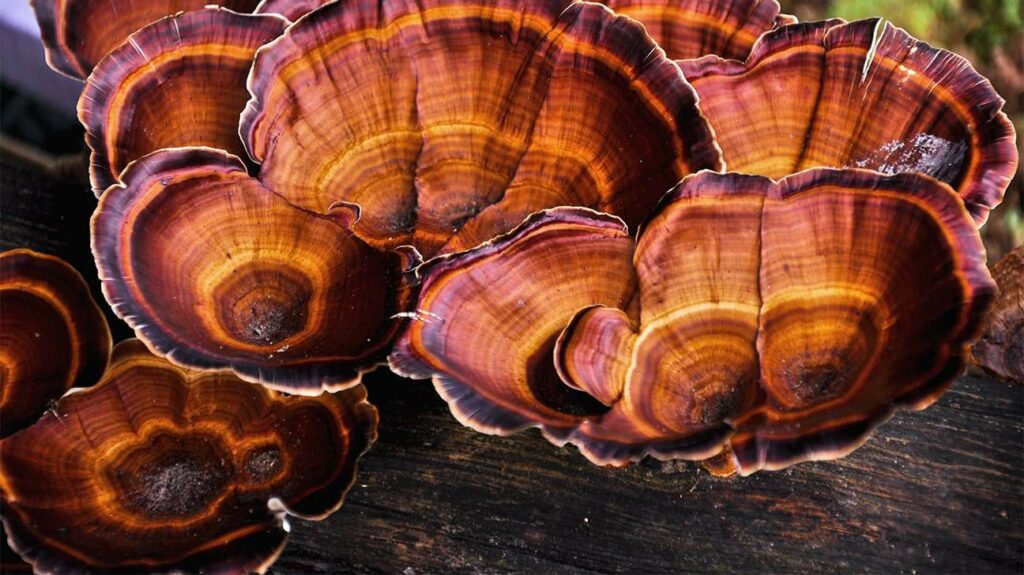
| Scientific Name | Ganoderma lingzhi |
| Common Name | Reishi Mushroom or Lingzhi |
| Family | Ganodermataceae |
| Toxicity (Touch) | No |
| Toxicity (Ingestion) | No |
| Unique Characteristics | Grow to about 30 inches wideKidney-shaped with a varnished, glossy appearance with a wood-liike texture |
Native to East Asia and Europe, the Reishi Mushroom or Lingzhi is considered a traditional medicinal mushroom across Asia.
The Chinese, in particular, regard the Reishi Mushroom as the “herb of potency”. Hence, the mushroom is available in various medicinal forms such as powders and teas.
It’s a bitter-tasting mushroom that’s widely believed to aid in boosting the immune system, promote better health, and reduce stress, among others.
Though, there is little data as far as modern science is concerned to back up these claims.
The Reishi Mushroom is rather large, growing to about 30 inches wide, with some weighing a whopping 11 pounds.
Its kidney-shaped cap has a rather varnished appearance, looking quite glossy and shiny despite its tough, wood-like texture.
As they age, their bright yellowish orange, scallop-shaped cap begins to fade to brown.
Reishi Mushrooms are a kind of shelf mushroom. Hence, they’re typically found growing horizontally from the trunk of deciduous trees, especially ones that are dead or are close to dying.
Apart from that, they’re quite resilient. They’re often resistant to contaminants, which makes them quite easy to grow.
13. Golden Trumpet
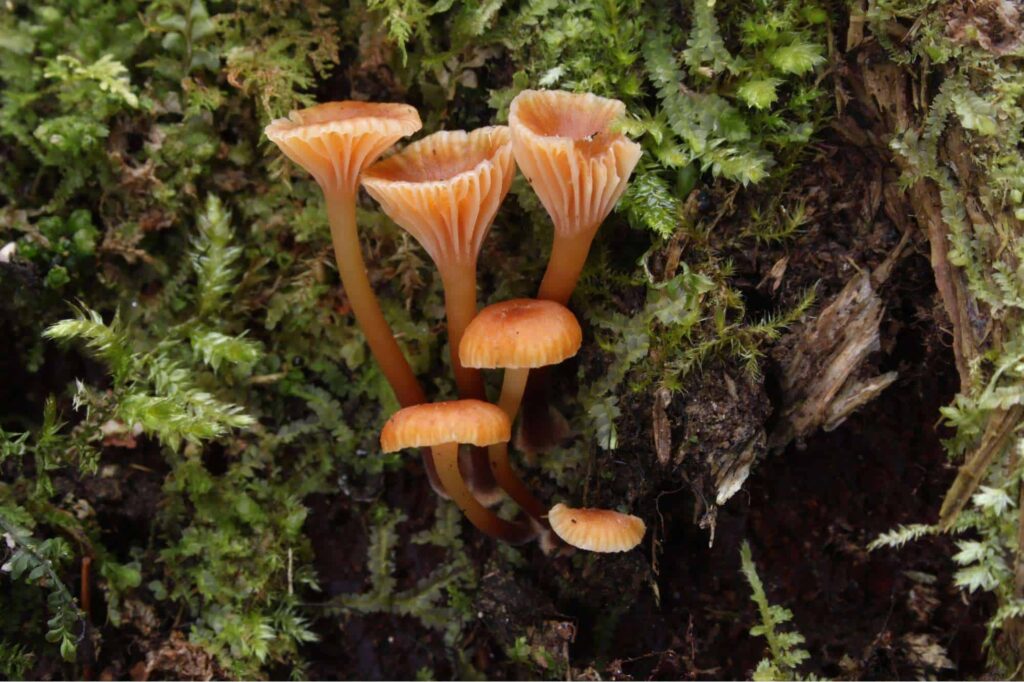
| Scientific Name | Xeromphalina Campanella |
| Common Name | Golden Trumpetor Omphalina Bellor Fuzzy Foot |
| Family | Marasmiaceae |
| Toxicity (Touch) | No |
| Toxicity (Ingestion) | No |
| Unique Characteristics | Inverted bell shapeResembles a belly button |
The Golden Trumpet is distinct for its inverted bell shape and resemblance to a belly button. In fact, its genus name, Xeromphalina Campanella, means “little dry navel” and “bell-shaped”, respectively.
Though, their caps tend to expand and flatten out as they age. So the “little dry navel” description only applies to the younger mushrooms.
Their caps only grow to about half a centimeter wide, while their thin stems only grow to about 5 centimeters long.
Beneath their cap they have gills that run along their upper portion of their stem. They’re spaced apart and are a pale yellow color.
They can be found in coniferous forests and, like many other mushroom varieties, grow on decaying wood. In fact, they’re often observed growing in clusters occupying entire tree stumps and wooden debris.
Among anywhere on the planet, they’re most commonly spotted in North America, especially during wet seasons.
While they aren’t known to be toxic, they’re not used as ingredients for any dishes since they’re pretty small and have a bitter taste.
14. Jackson’s Slender Amanita or American Slender Caesar
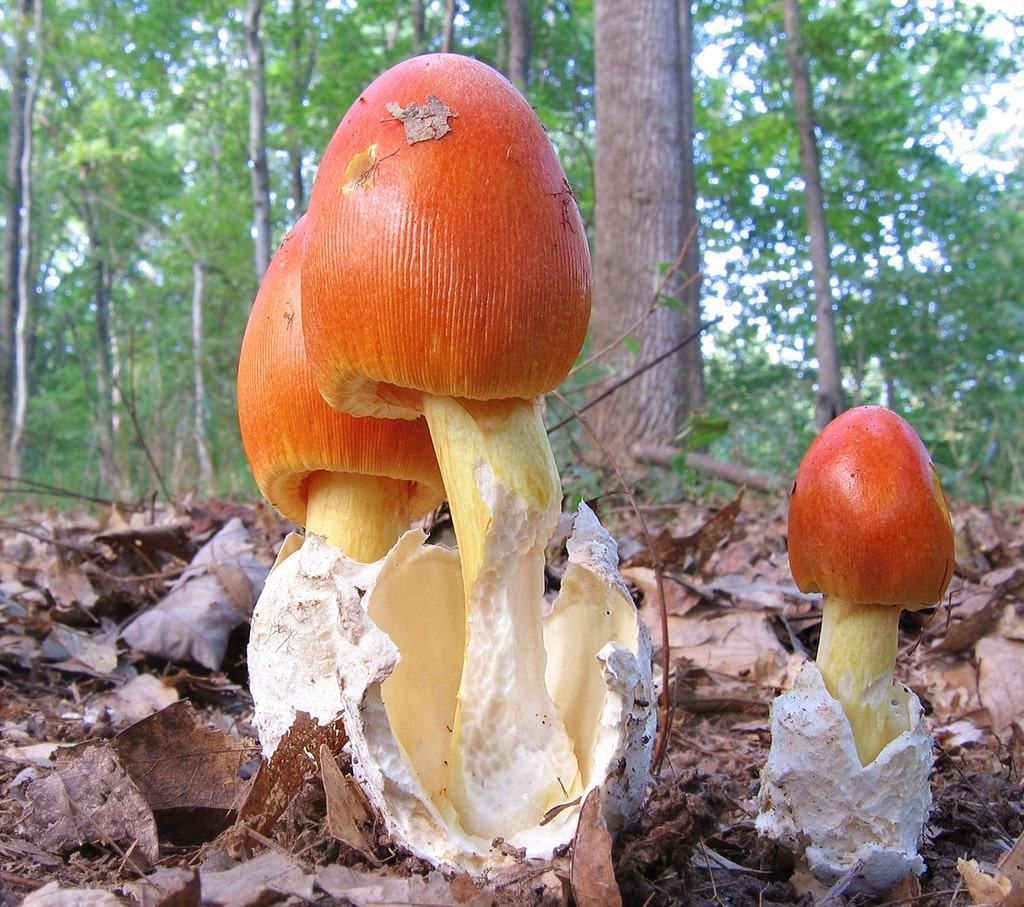
| Scientific Name | Amanita Jacksonii |
| Common Name | Jackson’s Slender Amanita or American Slender Caesaror Eastern Caesar’s Amanita |
| Family | Amanitaceae |
| Toxicity (Touch) | No |
| Toxicity (Ingestion) | No |
| Unique Characteristics | Has its original coating remnants by its baseCap develops streaks as it ages |
If the Jackson’s Slender Amanita or American Slender Caesar looks familiar, that’s probably because it has an uncanny resemblance to Caesar’s Mushroom (Amanita caesarea).
However, Caesar’s Mushroom is the European species. Hence, it doesn’t natively grow in the United States or Canada, unlike the Jackson’s Slender Amanita, which is most commonly found in North America.
It does have quite a few doppelgangers, though, which can get quite confusing as the name “Caesar” is used for the non-European varieties.
The Jackson’s Slender Amanita changes its appearance as it matures. When it’s younger, it looks like a white egg, but later opens up into a more traditionally-looking mushroom.
As it grows, it leaves its original egg-like coating behind and dawns a reddish orange hemispherical cap. Eventually, the cap changes from a convex shape to a more flat surface.
The middle of the cap’s also more noticeably orange, lightening towards the edges that are decorated with pale marginal streaks.
Even though the Jackson’s Slender Amanita isn’t toxic, it isn’t usually ingested since it resembles many deadlier Amanita species.
Having said that, we recommend that you also play it safe to avoid misidentifying the non-toxic species with a deadly one.
15. Hare’s Ear Fungi
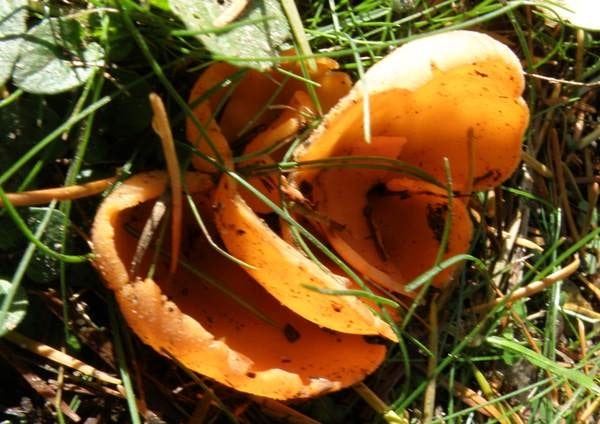
| Scientific Name | Otidea onotica |
| Common Name | Hare’s Ear Fungi or Lemon Peel Fungus |
| Family | Pyronemataceae |
| Toxicity (Touch) | No |
| Toxicity (Ingestion) | No |
| Unique Characteristics | Cup-like shape that folds inwardsHas a split along one side |
Since the Hare’s Ear Fungi is a member of the Otidea genus, they’re known to have a split along one side which results in their cup-like shape that folds inwards.
Arguably, this characteristic is often said to resemble a rabbit or hare ear and a lemon peel. Hence, the common names, “Hare’s Ear Fungi” and “Lemon Peel Fungus”.
Their cups are observed to have a yellowish orange color and only grow to about 3 centimeters across and 5 centimeters tall.
Even then, you’ll barely be able to spot their stems as they grow from the ground underneath coniferous trees as they feed on decaying organic materials.
They’re primarily located across Europe and North America, growing in clusters.
While they aren’t toxic, they don’t have much value as an ingredient, which is why they aren’t typically used for cooking.
However, it is believed that they possess medicinal properties. Though, this has yet to be scientifically proven.
16. Red Chanterelle or Cinnabar Red Chanterelle
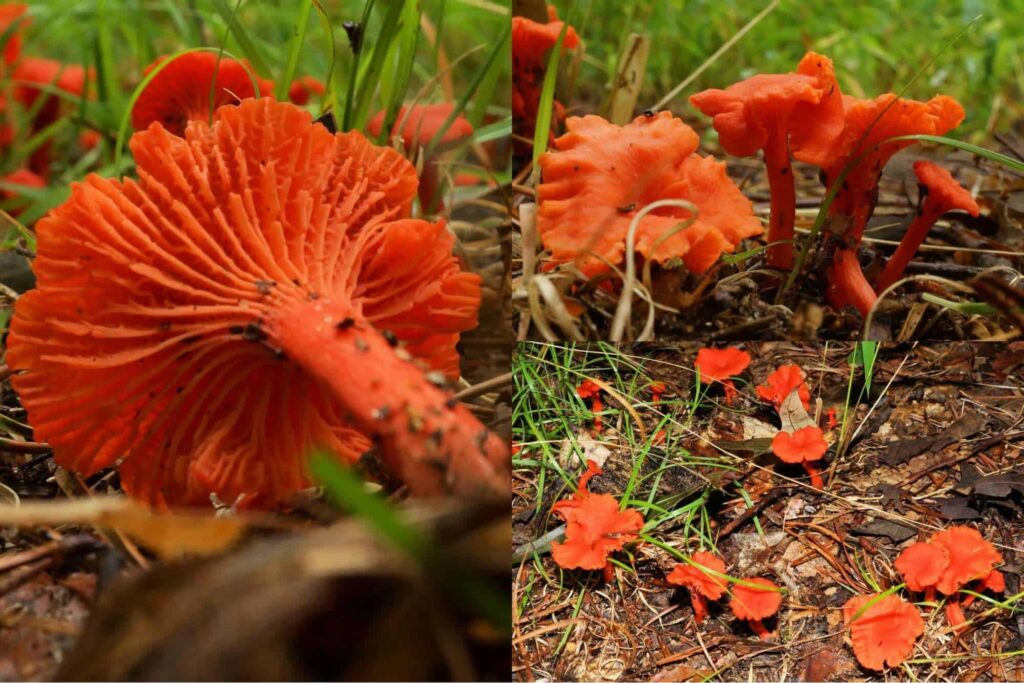
| Scientific Name | Cantharellus cinnabarinus |
| Common Name | Red Chanterelle or Cinnabar Red Chanterelle |
| Family | Cantharellaceae |
| Toxicity (Touch) | No |
| Toxicity (Ingestion) | No |
| Unique Characteristics | Has vein-like false gills that run from the edges of the cap to the upper part of the stem |
Native to Eastern North America, the Red Chanterelle was named after its bright reddish orange color. Though, sometimes they can be a pale pinkish orange shade, too.
The cap tends to change shape, from convex to flat, with some even developing thick and wavy margins.
This vase-shaped mushroom’s distinguishable characteristic is the vein-like false gills that run from the edges of the cap to the upper portion of the stem.
Like many other mushrooms, they can typically be found growing in small patches alongside hardwood trees and in mossy areas.
However, unlike other orange mushrooms, Red Chanterelles grow on the ground, not decomposing wood. They’re also known to prefer slightly more acidic soil conditions.
Luckily, it’s reported that all species of Chanterelles aren’t poisonous. However, be wary that they have a poisonous doppelganger – the Jack O’Lantern Mushroom (Omphalotus olearius).
Despite not having a strong flavor, Red Chanterelles are quite popular in the kitchen because of how they maintain their bright reddish orange color even when cooked.
17. Pycnoporellus fulgens
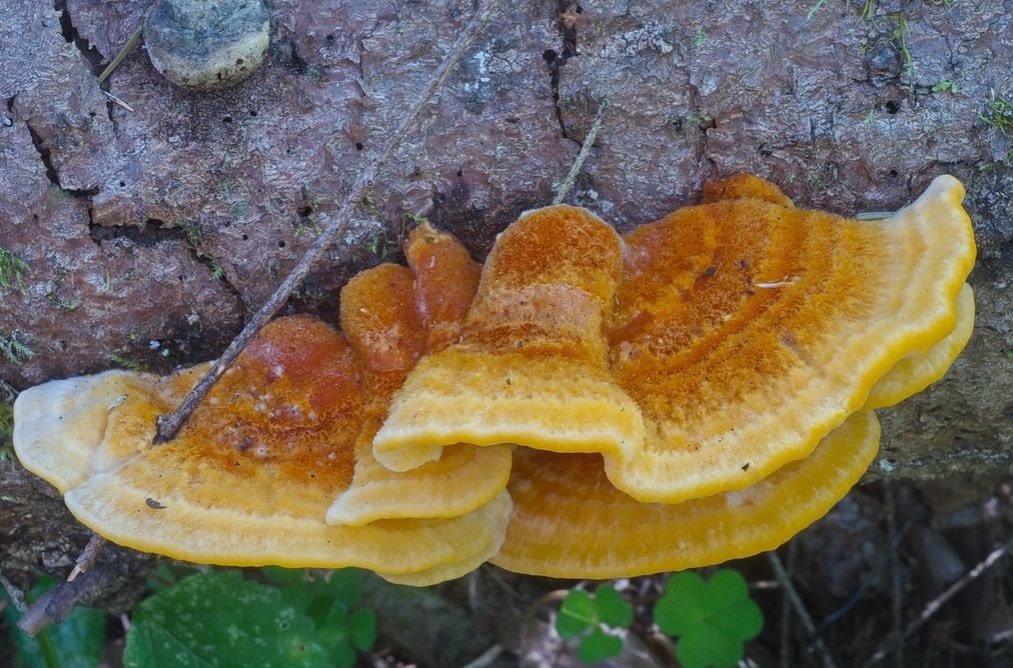
| Scientific Name | Pycnoporellus fulgens |
| Common Name | None |
| Family | Fomitopsidaceae |
| Toxicity (Touch) | Unknown |
| Toxicity (Ingestion) | Unknown |
| Unique Characteristic | Grow like shelvesFan-like appearance and shapeLighter margins and darker centers by the tree |
If it seems like you’ve already seen the Pycnoporellus fulgens, it may be because it has a close resemblance to the Chicken of the Woods mushroom because of their fan-like appearance and shape.
The color of their caps can range from a bright orange to a dull orangey brown shade. It also often feels velvety with very fine hairs.
As they age, their edges begin to lighten in color to a more cream-white and orange shade.
They appear like shelves on conifers, hardwood, and deciduous trees. In particular, they’ve been observed on spruce the most, but occasionally on pine, aspen, and birch as well.
Since they’re a type of saprobic fungi, you’ll only be able to spot them growing on decomposing wood such as groundwood, logs, or stumps.
The Pycnoporellus fulgens is native to Eurasia and Northern America. While they can be found in urban forests, they thrive best in old, decaying woodlands.
Though, because of their rarity, it’s unfortunate that they’ve been classified as an endangered species in nearly all of the countries where they’re present.
Nevertheless, reintroduction efforts have taken place to aid in their conservation and reduce their endangerment.
It’s unclear whether this species of orange mushroom is toxic by touch and ingestion. Though, they are typically eaten by several kinds of beetles in the wild.
18. Spectacular Rustgill or Laughing Gym/Jim
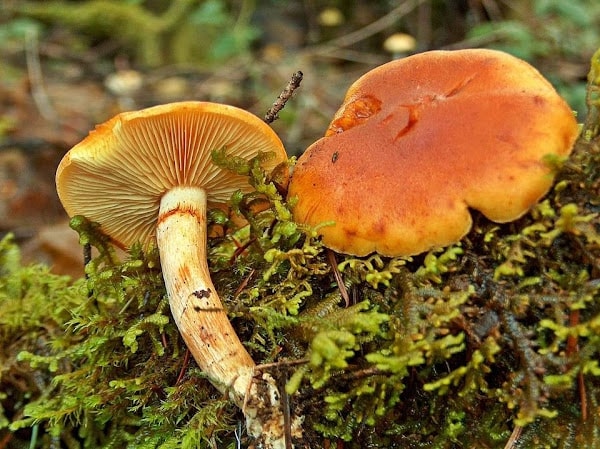
| Scientific Name | Gymnopilus junonius |
| Common Name | Spectacular Rustgillor Laughing Gym/Jim |
| Family | Strophariaceae |
| Toxicity (Touch) | Certain varieties |
| Toxicity (Ingestion) | No |
| Unique Characteristics | Cap has fine hairsConvex-shaped caps flatten out with age |
The Spectacular Rustgill is a fairly common orange mushroom that can be found across Australasia, Europe, and South America.
To be specific, they grow primarily in lowland wooded areas where there’s a lot of moisture in the environment.
They’re also known to grow in clusters but can be observed in solitary every now and then. You’ll be able to find them growing on the base of trees or dead logs.
Their caps are usually bright yellowish orange or orangey brown in color. Aside from that, their caps have fine hairs, too, and grow to up to 30 centimeters or 12 inches across.
Despite a rather large cap, they’re quite stout, with a stem that only grows to 10 inches at most.
Underneath their caps they have crowded and wrinkly looking gills. As they age, their gills change from a yellowish color to dark rusty shade.
When they’re young, they look like a traditional mushroom with convex caps with their edges rolled inwards. As they mature, their caps will flatten out a bit.
If you spot a Spectacular Rustgill, it’s best to leave them alone since several kinds of species are considered toxic. Hence, it’s better to play it safe to leave them be.
While this particular variety of rustgill mushrooms isn’t poisonous to ingest, it’s considered inedible due to how bitter it tastes.
19. Northern Cinnabar Polypore
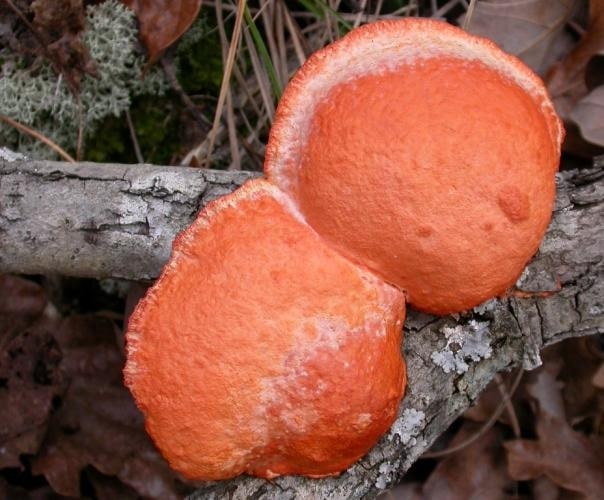
| Scientific Name | Pycnoporus cinnabarinus |
| Common Name | Northern Cinnabar Polypore or Cinnabar Polypore |
| Family | Polyporaceae |
| Toxicity (Touch) | Yes |
| Toxicity (Ingestion) | Yes |
| Unique Characteristics | Kidney-shapedHave light-colored poresSometimes don’t appear to have stemsGrow like shelves |
The Northern Cinnabar Polypore, or simply Cinnabar Polypore, is a well-known white-rot decomposer or lignin degrader. Fascinatingly, they turn these into carbon dioxide and water.
Their caps and stems are reddish orange while they’re young, but fade with age. Their caps grow to up to 13 centimeters across and are wrinkly, quite flat, and kidney-shaped with lighter-colored pores.
Sometimes they appear to have no stems and grow like shelves on decaying wood.
They’re usually seen across Europe, America, and Asia growing on deciduous hardwood trees. They’ve been observed to mostly grow on birch, beech, and cherry.
Even then, there are very few reports of Cinnabar Polypore sightings, especially in recent years. Given its rarity, it’s recommended not to collect these species of orange mushrooms to preserve their existence.
Like other fungi, they’re great at decomposing wood and other organic material. However, what makes the Cinnabar Polypore different is that they leave a whitish residue after they’re done.
Despite having been reported to emit toxic bacteria to protect itself, it’s considered by some to have promising medicinal benefits.
20. Burnt Orange Bolete
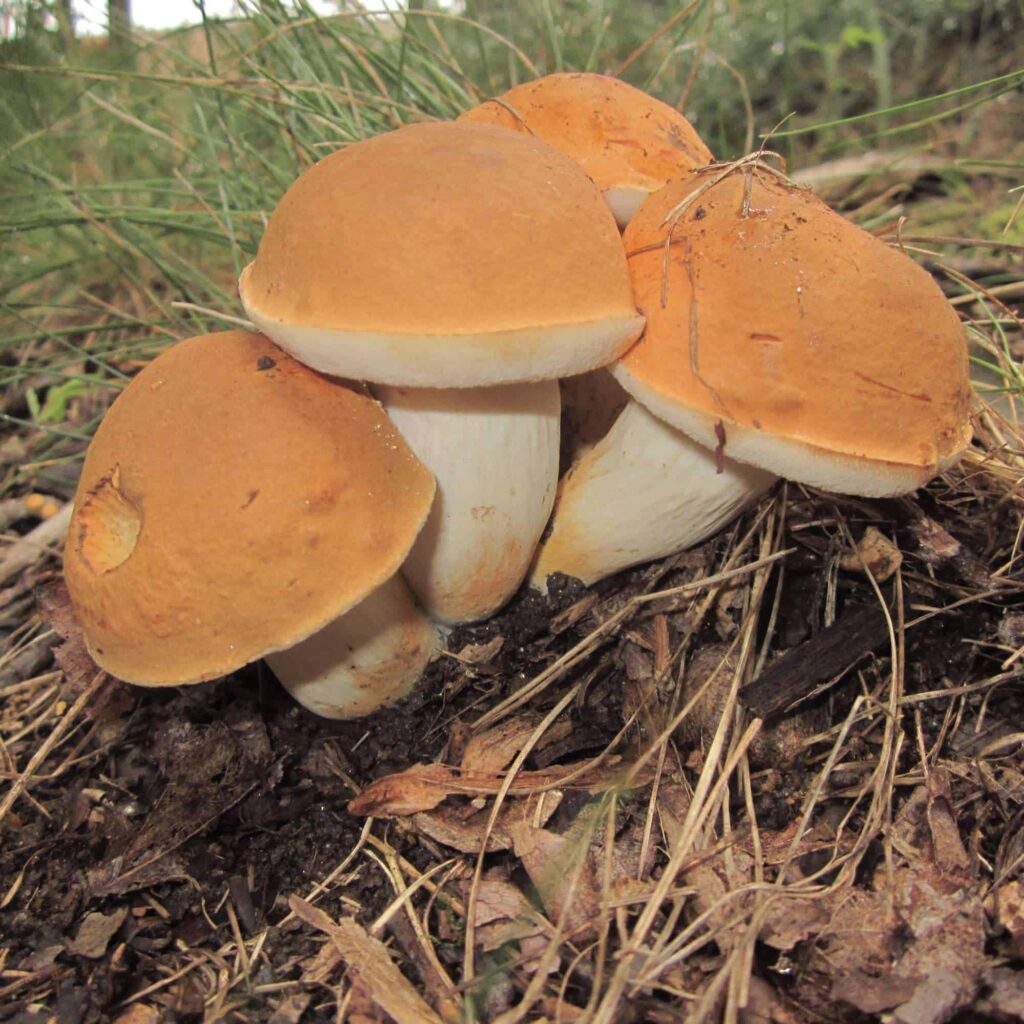
| Scientific Name | Tylopilus balloui |
| Common Name | Burnt Orange Bolete |
| Family | Leccinum |
| Toxicity (Touch) | No |
| Toxicity (Ingestion) | No |
| Unique Characteristics | Convex-shaped cap flattens out irregularly as it maturesWrinkled-looking stems |
The Burnt Orange Bolete got its name from its characteristically bright orange cap. Though, as it ages, the cap begins to turn into a duller brown shade, similar to other bolete varieties.
By the same token, the cap is often convex-shaped but flattens out irregularly as the mushroom matures. They get to become around 12 centimeters big, at most, with a soft flesh.
Its stem is primarily white with a tinge of pale yellow. These tubes can also look a tad wrinkled and have brown stains scattered across.
The underside is nearly the same color as the stem. Unlike other mushroom species, it doesn’t have gills, but is rather porous.
They typically grow in small clusters, but are occasionally found solitary. You’ll find them under hardwoods or pines
While they don’t have a particularly distinctive taste or smell, they are edible. Though, there aren’t many recipes available to follow.
How to get Rid of Orange Mushrooms?
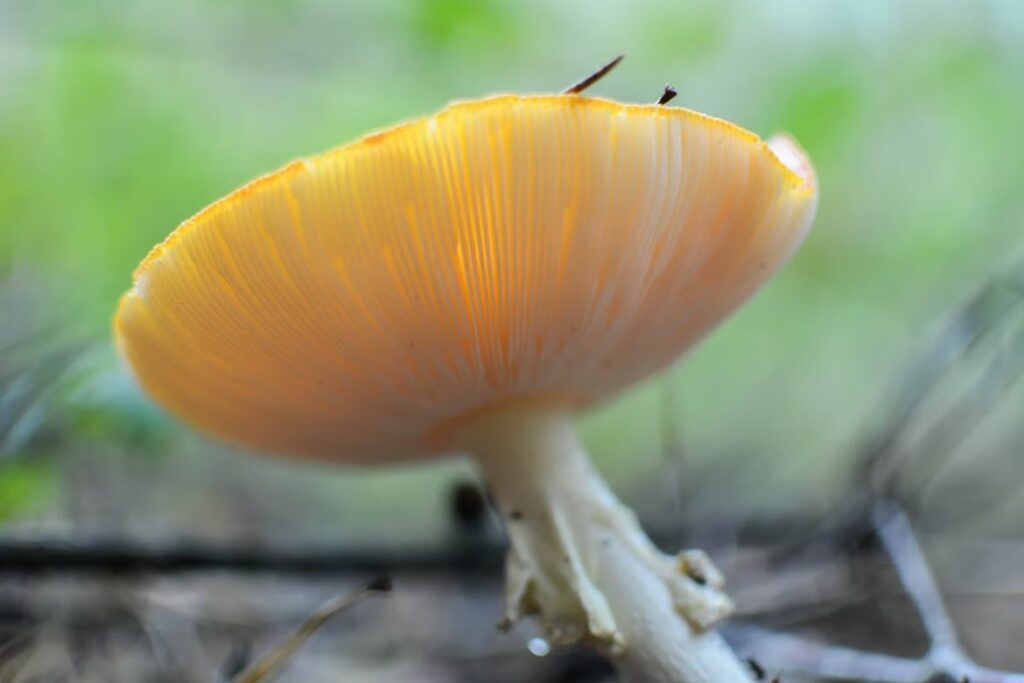
If you’re not a fan of having orange mushrooms, toxic or not, on your property then you’re in luck.
We’ve got a few tricks up our sleeve to help you easily get rid of them, from using fungicides to more organic solutions like vinegar. Read our comprehensive guide to learn more!
1. Fungicide
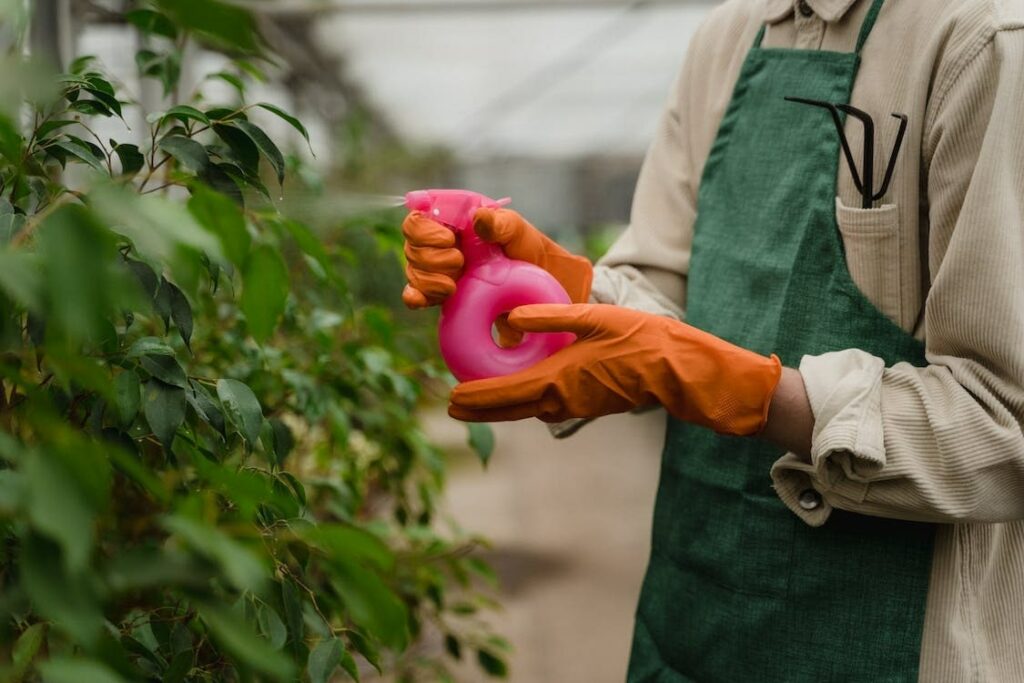
One of the most effective ways to get rid of unwanted orange mushrooms is to treat them with fungicide. This is because they tackle the orange mushrooms right at their source, preventing it from coming back.
Luckily, it’s pretty easy to find several kinds on the market, depending on what you’re looking for.
They come in liquid concentrate and granules, too. Hence, you can simply pick up whichever best fits your preference when it comes to application.
For easier application, you can also purchase different kinds of sprayer attachments.
Though, do keep in mind that fungicides can be quite toxic. They’re best used away from children and pets.
Having mentioned that, be sure to carefully read and follow the manufacturer’s instructions to achieve ideal results. Don’t forget to wear protective equipment such as gloves and a mask, too.
If you’re not one for manual labor, then you could enlist the help of a professional to do the work for you.
What To Do
- Wear protective equipment such as gloves and a mask.
- Apply the fungicide treatment as prescribed by the manufacturer’s instructions.
- Once the orange mushroom is dead, dig it out of the ground and dispose of it inside a plastic bag. Seal tightly and throw away.
2. Vinegar

If you’re not one for using chemicals, opting for vinegar could be a better, more organic alternative for you. To boot, it’s likely that you already have some vinegar lying around in your kitchen.
This affordable solution is an effective way to get rid of unwanted orange mushrooms because it contains acetic acid.
Regular household vinegar is known to have about 4 to 8% acetic acid concentration. Despite being effective orange mushroom killers, it’ll take a while to see results and you may have to reapply.
Alternatively, you could use horticultural vinegar which has about 30% acetic acid concentration. This ensures a faster and more thorough result.
Do note that vinegar could kill other plants within the immediate vicinity when used on them. Hence, you’ll want to apply it carefully to avoid any unwanted casualties in your garden.
What To Do
- Mix 1 part vinegar and 4 parts water into a spray bottle.
- Spray the solution directly onto the unwanted orange mushrooms.
- Once the orange mushroom is dead, dig it out of the ground and dispose of it inside a plastic bag. Seal tightly and throw away.
3. Baking Soda

Baking soda is another organic alternative to fungicides and harsh chemicals. This is also the preferred method for individuals with pets and children around.
They’re also quite affordable and most likely already in your pantry, to boot.
While baking soda itself doesn’t directly kill the orange mushroom, its presence in the soil will increase its alkaline levels.
As a result, the soil won’t be ideal for orange mushroom growth. After a while, the orange mushroom will die due to the poor conditions.
Nevertheless, results will only take a few days to about a week, at most.
Having said that, be wary of where you’re applying the mixture as you wouldn’t want to raise the alkaline level of the soil of your other plants.
You may also want to take into account the fact that the changes in the treated soil’s pH level could present difficulties in growing other plant varieties in the immediate area.
What To Do
- Mix 1 gallon of water with 1 tablespoon of baking soda. Stir well until the two ingredients have become well-combined.
- Apply the mixture generously only to the unwanted orange mushroom and the surrounding soil.
- Continuously reapply the solution after a couple of days. Over time, it will inhibit growth and kill the orange mushroom.
- Once the orange mushroom is dead, dig it out of the ground and dispose of it inside a plastic bag. Seal tightly and throw away.
4. Dish Soap

Before anything else, we do have to warn you that the dish soap option is a rather lengthy one.
Because it’s a rather tedious process, don’t expect a fast turnover of results as it requires repeated applications.
However, the dish soap method may be the most effective. This is because it can go as far as to kill the spores, ensuring that there won’t be a regrowth of unwanted orange mushrooms on the treated areas.
What To Do
- Mix 1 to 2 tablespoons of dish soap (any variety or brand will do) with 3 gallons of water. Stir well until the two ingredients have become well-combined.
- Poke several deep holes into the immediate area where the orange mushroom is growing.
- Pour the soapy water mixture directly into the holes. Generously cover the immediate area, too, to ensure that spores are killed.
- To ensure speedy results, repeat the process a couple of times a day for the course of a week.
5. By Hand
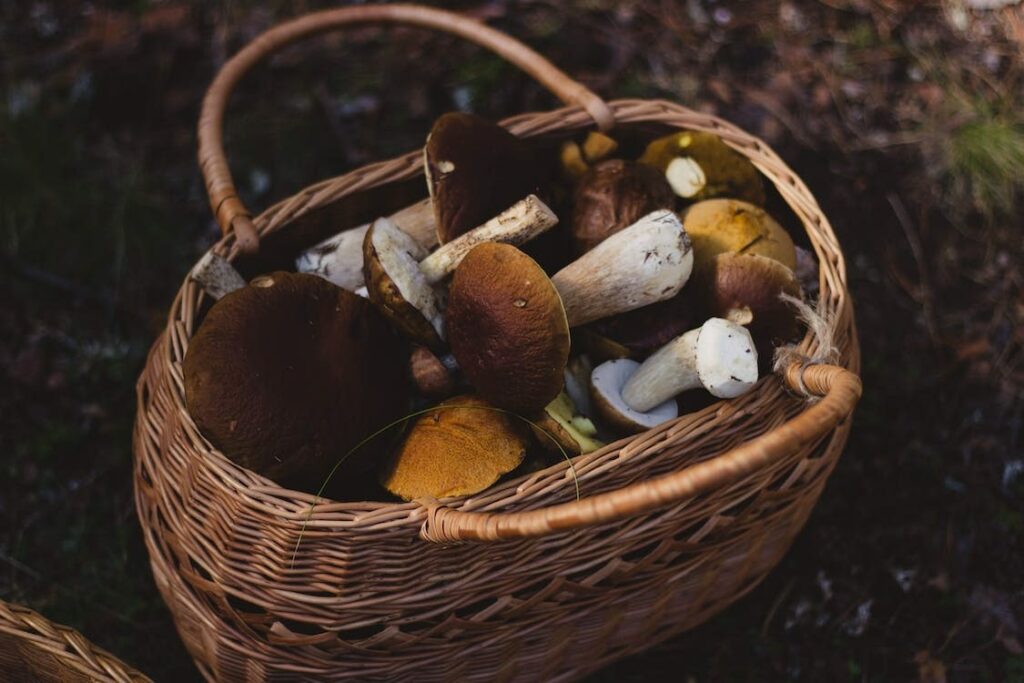
The easiest way to remove orange mushrooms from your garden or backyard is by simply plucking them.
The best time to do so is right when you see caps appearing from the ground. You’ll want to get rid of them before they’re mature and large enough to start releasing spores.
Refrain from simply plucking off the orange mushroom lightly as you want to get it out completely to prevent it from regrowing.
It’s important to note that the orange mushroom is simply the fruit of its root system, the mycelium.
While orange mushrooms don’t have a root system like most plants, the mycelium keeps them rooted in their place.
Hence, you’ll want to get in pretty deep into the soil when removing them.
Having mentioned that, you don’t want to compost any unwanted orange mushrooms either. Because of their spores, they could simply continue to spread.
What To Do
- First thing’s first: wear protective equipment. Put on some gloves before handling any of the orange mushrooms.
- After picking them up, dispose of them in a trash bag.
For extra measure you could carefully crush them, too. You’ll want to do this while they’re inside the trash bag to lessen the likelihood of them spreading any more spores.
- Once you’re done collecting all of the unwanted orange mushrooms, seal the bag tightly and throw it away.
As the icing on the cake, you could also apply fungicide on the area where you plucked the orange mushroom.
This is because it could have already shed spores, which means that reproduction could be around the corner. Before you know it, there’ll be even more unwanted orange mushrooms growing.
How to Prevent Orange Mushrooms From Growing?
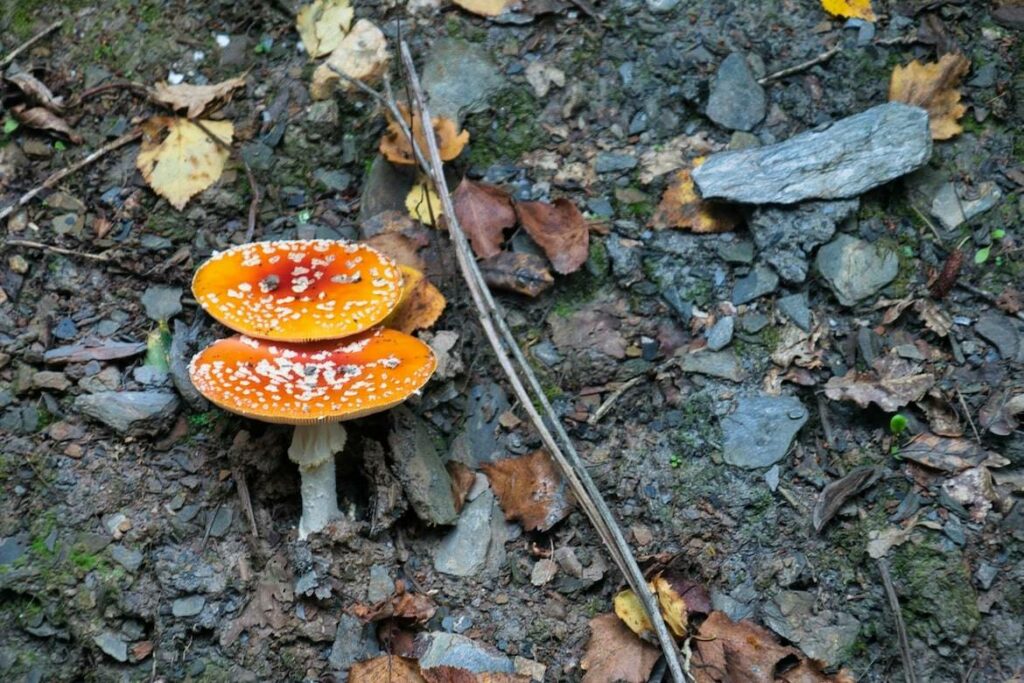
As mentioned earlier, orange mushrooms don’t just grow anywhere. It takes a specific combination of just the right environmental conditions to grow and thrive.
Having said that, you can actually alter these conditions to ensure that they aren’t favorable for orange mushroom growth.
We’ve listed down a couple of practices that you can incorporate into your gardening routine to inhibit their presence in your garden or yard.
1. Improve Lawn Drainage
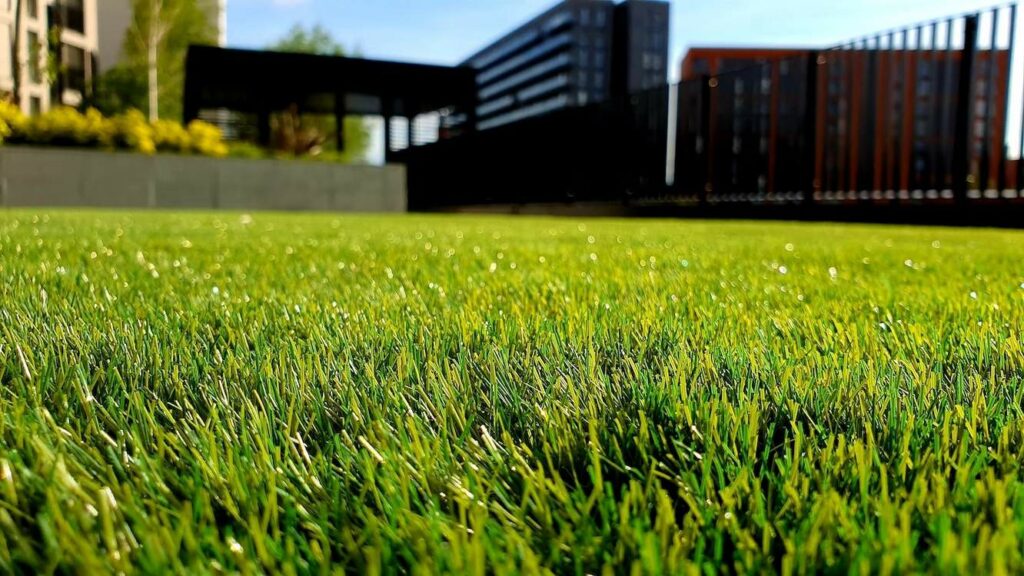
If your garden is often wet or experiences frequent rainfall, you may have noticed orange mushrooms popping up more.
This is because mushrooms love water as it helps boost orange mushroom growth and reproduction rates.
Organic materials that hold moisture such as logs, tree barks, and the like are where you’ll most likely find orange mushrooms growing.
Because orange mushrooms love damp areas, you have to ensure that your lawn or garden is able to drain properly.
If you’re not sure about how well your garden or lawn drains, keep a close eye on where the water goes whenever it rains.
Does it gather into a puddle at a single spot? Does it easily make its way to your designated draining areas?
Once you’ve figured out these problems, it’ll be easier for you to figure out how to reroute the excess water or correct poor drainage systems.
What To Do
- If you have clay soil, it’s too compacted to allow air to flow through. As a result, it’ll hold all the water.
To fix this, you’ll want to aerate your soil by amending the soil with some well-draining materials such as sand. This helps increase air pockets for your soil to breathe and dry up quicker.
- Extend a downspout from your gutter into a large basin or barrel to catch excess water. This will prevent the water from soaking into your garden.
You can use this to water your plants. Alternatively, you could build a pond as a decorative feature to catch the water.
- Improve your existing underground drainage system. If you suspect that there’s something clogging your built-in drainage system, it may be time that you call in a plumber to perform an inspection.
2. Dethatch Your Lawn
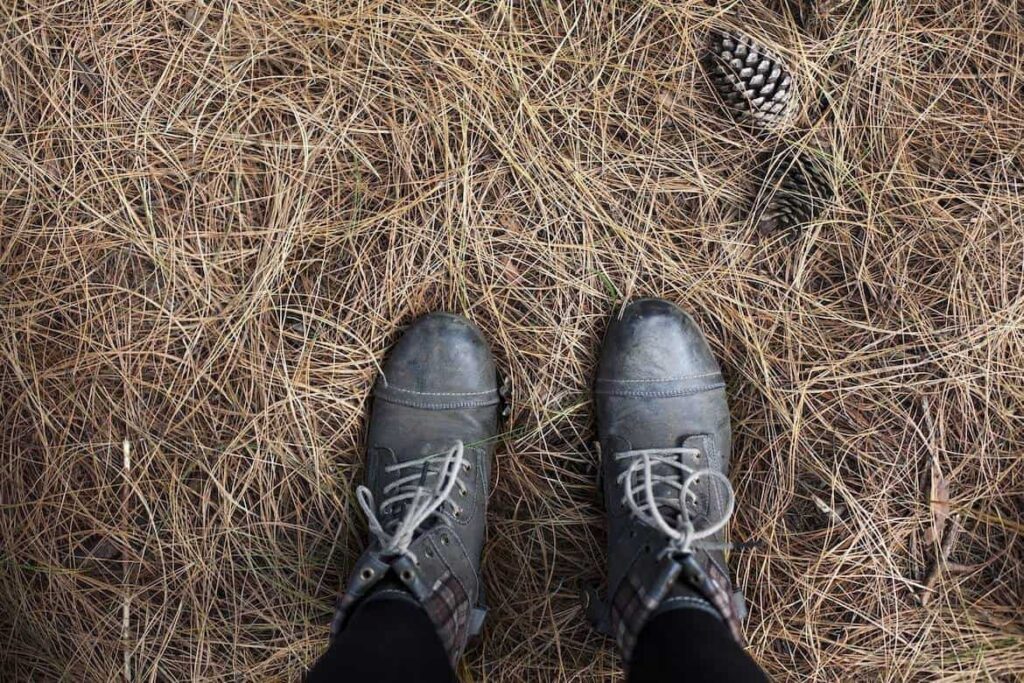
Dethatching is the process of removing dead grass and thick organic matter from a turf.
This is an essential part of keeping unwanted orange mushrooms of any kind away as dead grass and similar organic matter keep the soil moist.
As stated previously, damp soil conditions encourage orange mushroom growth. So if you’ve spotted a couple of orange mushrooms growing from a thick layer of grass trimmings, take it as a sign to stop putting off their removal.
What To Do
Clear out all of the dead grass from the property. To collect them easily, you can use a wide rake to bring them all into one area.
From there, chuck them into large garbage bags. Alternatively, you can add them to your compost bin, as mulch on top soil, or as an additional layer in your raised beds.
3. Clear Organic Materials
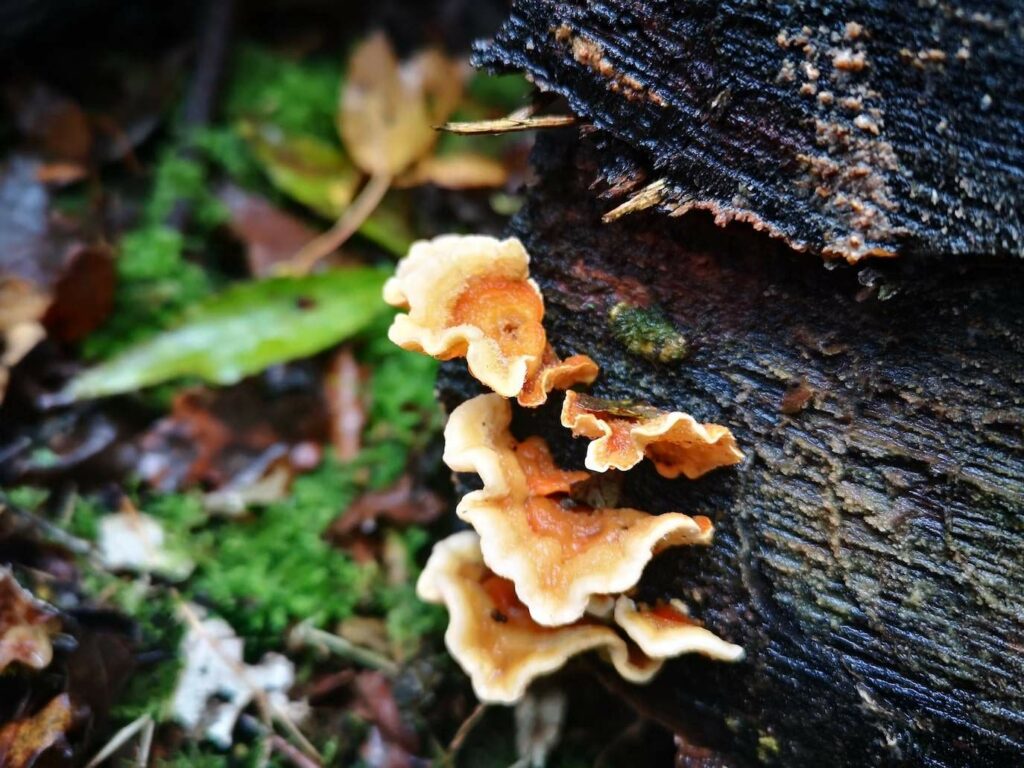
An important fact to know about orange mushrooms is that they absolutely love organic materials.
As nature’s decomposers, they break down any kind of organic materials to create their own food. This is because they don’t have chlorophyll like other plant varieties.
In the wild, they’re most often observed growing on dead tree logs, stumps, and barks, to name a few.
Hence, having a couple of dead logs and barks laying around on your property can be considered an invitation for these unwanted orange mushrooms.
Aside from that, leaving grass clippings and fallen leaves around, especially when wet, also increases moisture retention.
What To Do
The best course of action to take would be to properly dispose of them. You can either throw them out or add them to your compost bin or as a layer to your raised bed.
4. Only Water Early in the Morning

Watering your plants early in the morning ensures that they’ve been given enough time to properly absorb the water before it evaporates.
This also goes for ensuring that excess water dries up before nightfall. Without sunlight, wet soil will most likely remain damp until the following morning.
Keeping wet puddles around will become a breeding ground for all sorts of fungi to grow. This could also promote the spread of harmful diseases.
What To Do
Heavily water your plants first thing in the morning. If they appear to require more water, especially during the summertime, feel free to do a second round of watering.
However, refrain from doing so close to nightfall.
5. Apply High Nitrogen Fertilizer

Applying high nitrogen fertilizer is a great way to prevent orange mushrooms from sprouting by increasing the decaying rate of organic materials.
By hastening the pace at which decaying matter decomposes, this also shortens the lifespan of the orange mushroom.
This is a win-win situation since the boost in nitrogen within the soil will also help stimulate growth.
What To Do
- Before anything else, put on protective gear such as a mask and gloves.
- Simply apply the high nitrogen fertilizer as prescribed in the manufacturer’s instructions.
- Apply a generous amount to any organic matter that you either don’t want to get rid of yet or cannot dispose of at the moment.
- This will deter orange mushrooms from making them their new home.
6. Apply Fungicide Treatment
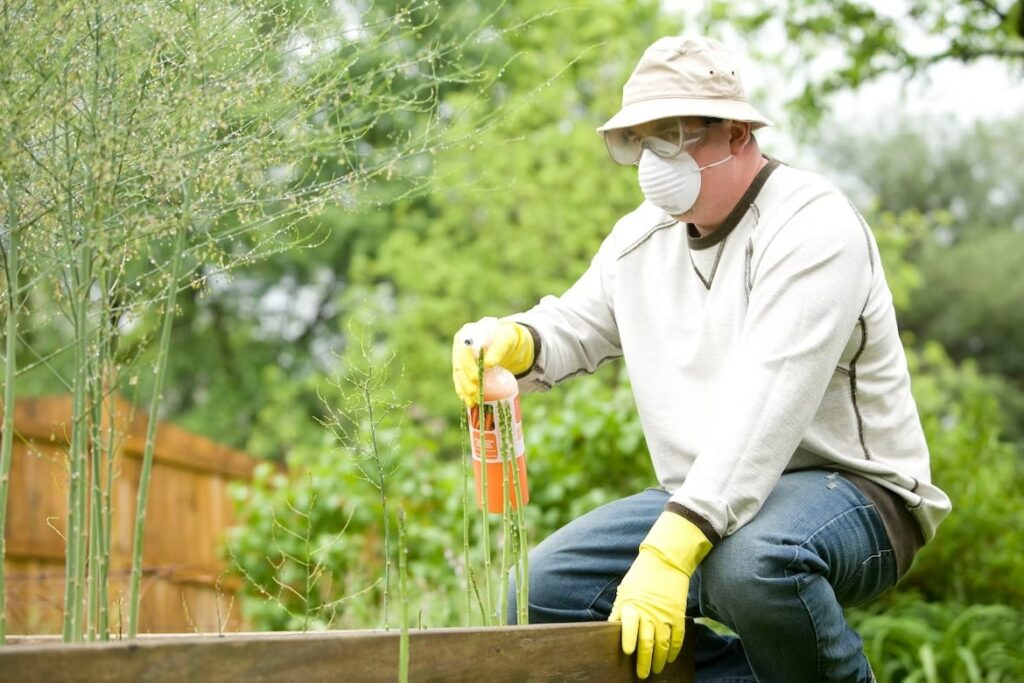
Treating your soil with fungicide is an effective way to get down to a primary cause of orange mushroom growth – dormant orange mushroom spores in the soil.
Since orange mushrooms are often referred to as the “fruits” of the fungi, it could mean that there are orange mushroom spores hiding in your soil just waiting for the right time.
Hence, fungicides are a great way to prevent orange mushrooms from sprouting from your soil or stumps.
They’re also quite easy to apply as they come in various forms depending on your preferred method of application. To be specific, there are liquid concentrate and granule varieties.
Apart from that, they’re quite simple to use, too. Be sure to carefully read the manufacturer’s instructions as some will require additional steps such as to dilute the product with water.
Reading the instructions also ensures that you achieve your desired results.
What To Do
- Put on protective gear such as gloves and a mask before handling the fungicide.
- Generously apply the fungicide as prescribed by the manufacturer’s instructions on areas where orange mushrooms often sprout.
7. Promote sunlight
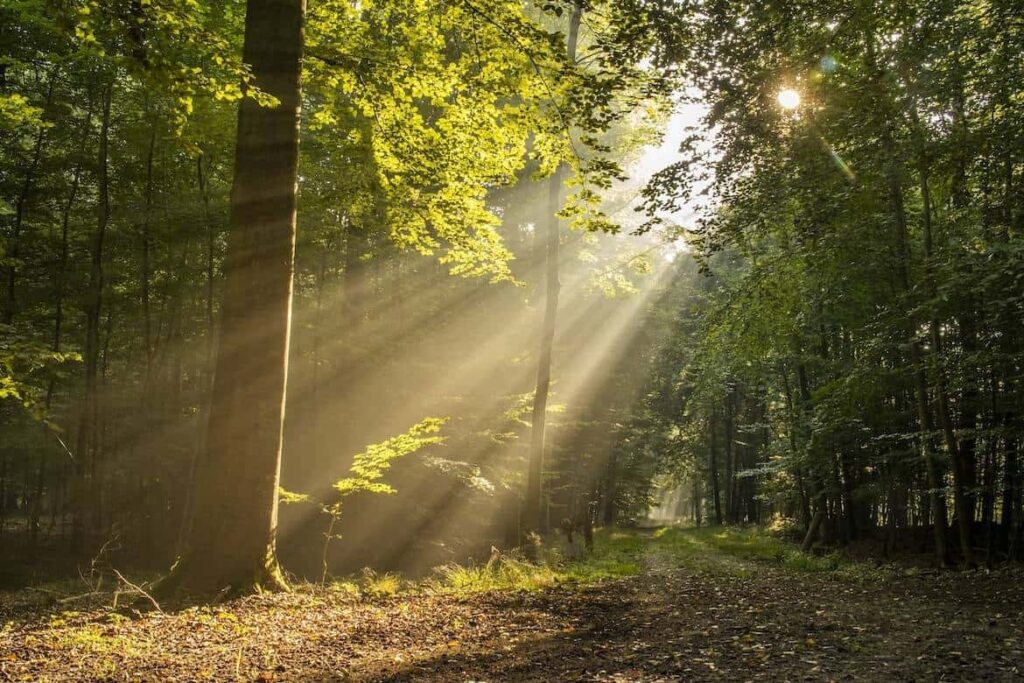
Sunlight is important to ensure that there aren’t any damp spots in your garden. This also allows the sun to penetrate and help dry up any excess water that has accumulated.
Apart from that, too much shade encourages orange mushroom growth since they tend to sprout in dark areas.
What To Do
If you’ve got small, manageable trees, you’ll want to prune their branches by cutting at an angle downwards.
Otherwise, you may want to hire a professional for larger trees with thicker branches.
FAQs About Orange Mushrooms
There are certain orange mushroom varieties that are completely safe to eat. These include the likes of Caesar’s Mushroom and Chicken of the Woods, both of which are popular cooking ingredients.
However, there are also several species of orange mushrooms that are poisonous. This includes the Jack-o’lantern mushroom which is considered toxic whether it be eaten raw or cooked.
The most common sign that an orange mushroom is poisonous are:
⮕White gills
⮕Ring around the stem
⮕Sack around the base
⮕Red colored caps or stems
It’s believed that some wild animals have developed a tolerance to the toxins present in orange mushrooms that are poisonous to humans.
However, domesticated animals are a different story. For safety’s sake, it’s best to leave wild and unknown orange mushrooms as if they were poisonous.
Orange mushrooms are a great addition to any lawn or garden because they’re natural decomposers.
They’re helpful organisms that feed on organic material such as dead wood, branches, stumps, and the like.
After these have been broken down, the orange mushrooms turn them into beneficial nutrients for your soil.
Orange mushrooms can die on their own once they don’t have anything left to feed on. So once the organic matter that they’ve been breaking down is gone, they’ll eventually disappear, too.



